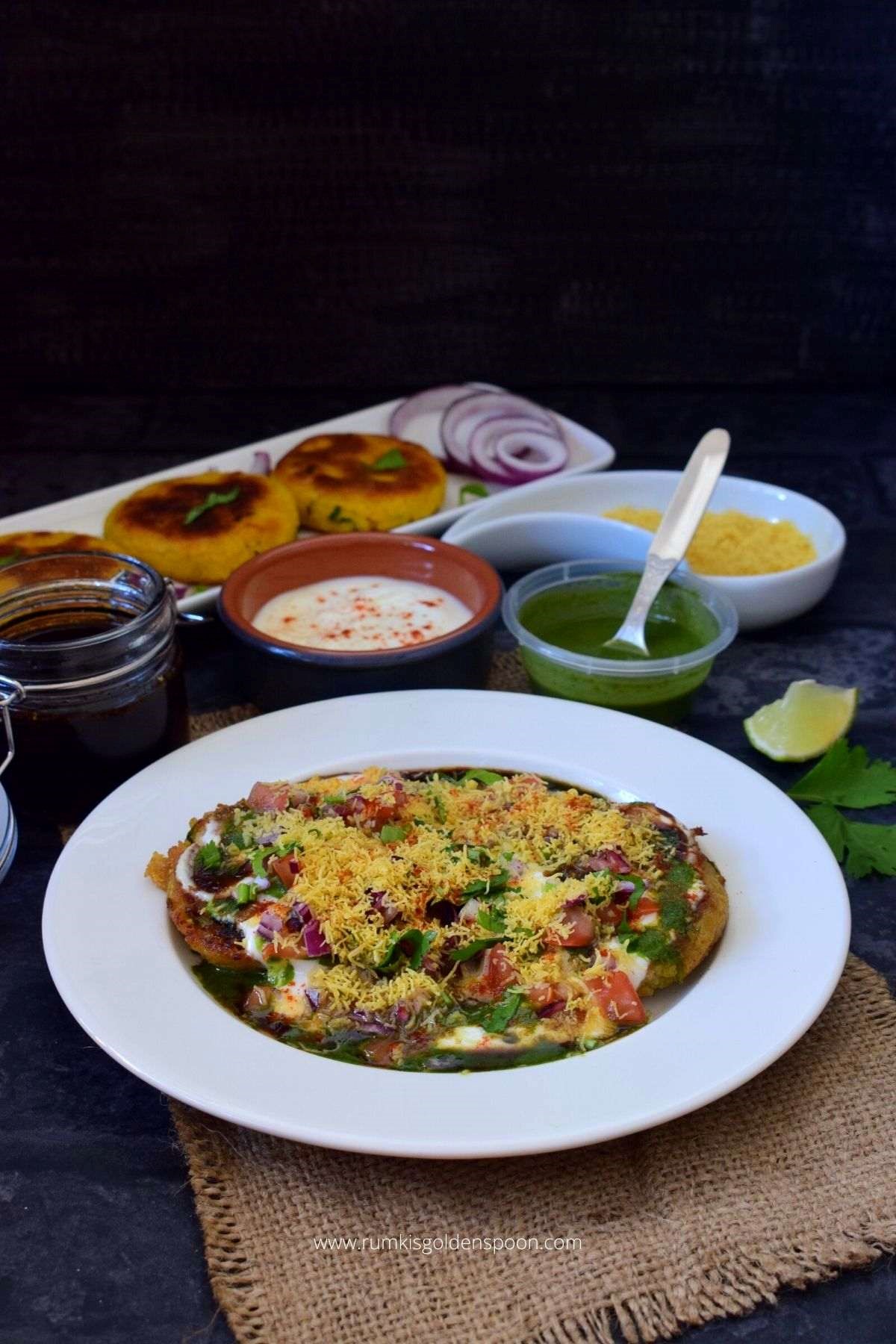Dhokar dalna aka Bengali dhokar dalna is a scrumptious, spicy and flavoured traditional Bengali recipe which is crazily popular among Bengalis. It is a pure niramish recipe, I mean no onion no garlic recipe which is perfect for Bengali vegetarian days and puja days. In this preparation, lentil cake pieces are cooked in tomato gravy with some potato chunks and specific spices. This versatile niramish tarkari is an asset of Bengali cuisine which is prepared on special occasions in every Bengali household, especially during the Durga puja festival. Dhokar dalna recipe is mostly relished with luchi, paratha, koraishutir kochuri, Basanti pulao and even with plain rice.
Many people think there is nothing called Bengali veg recipe. Few people also have the misconception that Bengalis eat only fish in their meal with some sides like dal, saag etc. But there is a treasure of many rich, delectable and flavoured Bengali veg dishes in Bengali cuisine. Aloo posto, doi begun, chanar dalna, dhokar dalna, niramish aloo dum, aloo phulkopir dalna are the few finest examples of it.
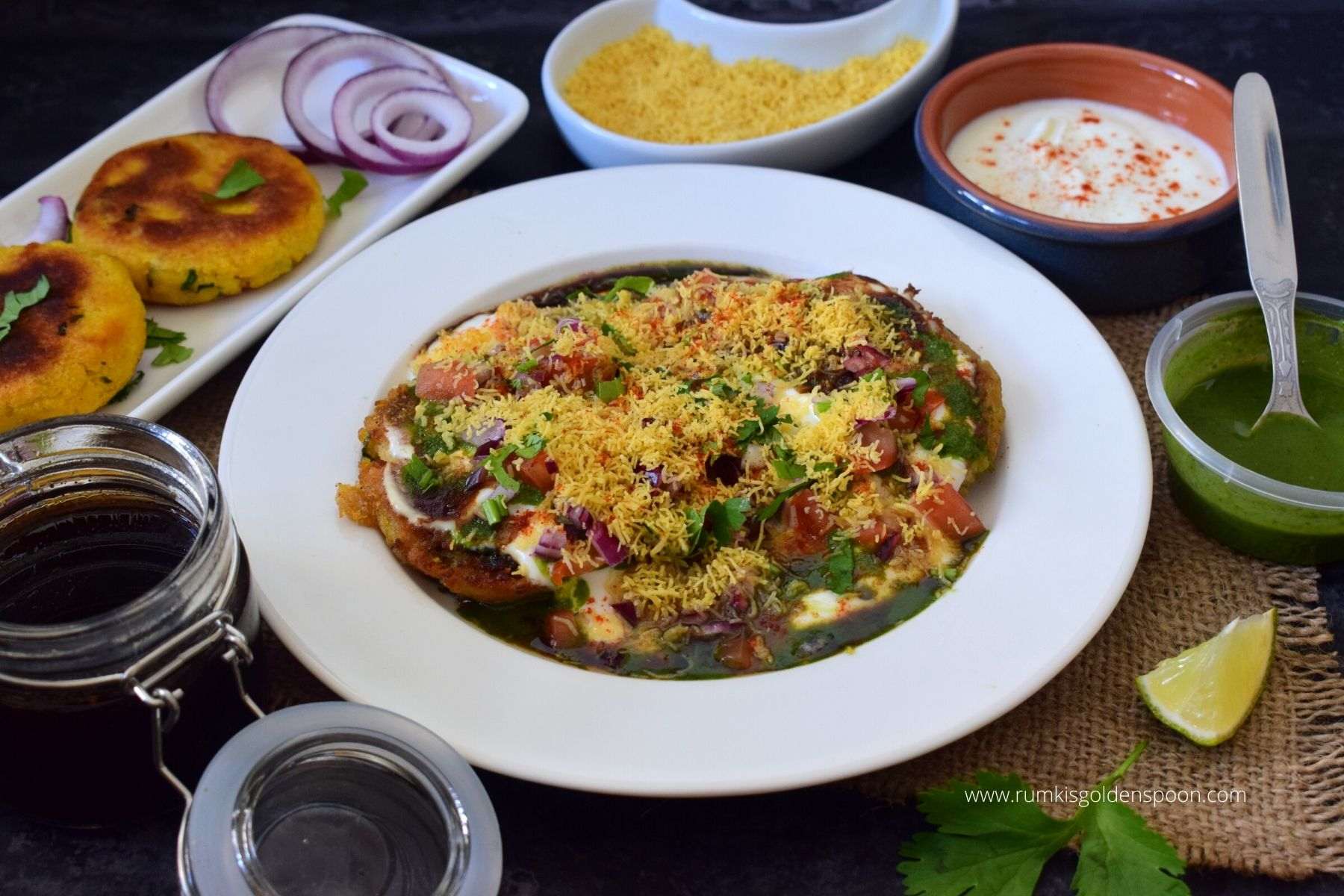
Table of Contents
About the recipe
Tips and Suggestions
How to make Dhokar dalna (step wise photos)
Recipe Card
What is dhokar dalna?
Dhokar dalna is a pure Bengali delicacy where the word ‘Dhoka’ has a dual meaning. One meaning of dhoka for the recipe is ‘lentil cake’ and another meaning of it is ‘betrayal’. My granny used to tell me a story that during vegetarian days aka meatless days her mother and granny used to cook dhokar dalna and told them it’s a mutton curry. Most of the kids including my granny used to have it with immense pleasure. In this way, almost every Bengali homemaker used to tell their kids this lie so that their kids can have food happily on vegetarian days. That’s why it is called Dhoka. On the other hand, ‘Dalna’ is basically a Bengali speciality in which the curry is prepared without using onion-garlic and the consistency of the gravy is slightly runny.
Dhoka is basically a Lentil cake prepared with Bengali gram aka chana dal. Few people mix yellow lentils aka matar dal too. But I have used only chana dal for the recipe. For the dhoka batter, the lentils need to be soaked in water for at least 6 hours or for overnight. Then the soaked lentil is drained and grinded to a paste with some green chillies, seasoning and spices. Then it is slow cooked till the batter turns a mass. After this, it is flattened and cut into diamond or square shapes. Finally, those pieces are deep fried till crispy and golden brown.
Dhoka’r dalna is mostly prepared in a vegetarian way. Though this dish is prepared with lentils & veggies but still Bengalis are scrupulous about vegetarian food and they split it into two different parts. One division is called satvik food where onion, garlic and even masoor dal are prohibited along with non-vegetarian items. In another division, normal vegetarian dishes are prepared using onion and garlic. Onion and garlic are considered as rajasik food which produces heat in our body and inflames our passion and incomprehension.
Whenever I talk about dhokar dalna, it always makes me feel nostalgic. As a bong, I have grown up eating this delicacy and have never gotten bored with it yet. I still remember how my mother used to prepare it on vegetarian days and puja days. She used to serve it mostly as a side with phulko luchi or with plain rice and we used to devour that with immense pleasure. I have learned this traditional Bengali food recipe from her.
When I was in Kolkata, I used to get numerous options of authentic Bengali restaurants where they serve fantastic dhokar dalna. But after moving to London, I started craving for the luscious Bengali dish. So, one day during Durga puja, I decided to prepare Dhoka’r dalna and basanti pulao on my own. Then I called up my mom and noted down the recipe. To be honest, on my first attempt the result came out very good but on my second attempt, it came out fantastic. After that, I never turned back and this recipe has become one of the most demanding niramish dishes for our family.
Dhokar dalna aka Bengali dhokar dalna is one of the most beloved niramish recipes which require very limited ingredients to get prepared. All the ingredients are easily available in any Bengali kitchen pantry. The difficulty level of preparing this dish is moderate and according to me, it’s not a novice recipe. The process of preparing this dish is a bit lengthy but I can assure you that it’s completely worth spending each minute on the recipe. It is a pure Bengali delicacy and you will get the essence of Bengal in it. The best part of the recipe is that you don’t need to drop your tears for slicing onions. It could be a great option for no onion no garlic days.
Dhokar dalna with step-by-step photos and instructions have been provided in the ‘Instruction’ section of the recipe. I have included all the tips and tricks below. If you follow each step of my recipe precisely then you will get Bengali dhokar dalna with perfect flavour and consistency which will even taste better than in restaurants.
Tips to prepare perfect dhokar dalna
- Wash the chana dal aka Bengal gram 2-3 times and soak it in sufficient water for at least 6 hours to overnight.
- Use the required amount of water to grind the lentil. Don’t add too much water and make the batter runny.
- The addition of roasted and peeled peanuts enhances the flavour and taste of dhoka. Crush the roasted peanut in a mortar pestle before adding it to the dhoka batter for a better texture. If you add whole peanuts then you can phase difficulty during the time of cutting the dhoka.
- Always slow cook the batter on low flame and stir it continuously or else it won’t get cooked evenly.
- After cooking the batter, spread it immediately on an oil-applied surface and flatten it evenly. If the mass gets cold, you won’t be able to flatten it. Cracks will occur.
- Cut the dhoka according to your desired shape and size.
- Deep fry the dhoka over medium flame till golden brown. Flip the dhoka very carefully in between for even roasting. Dhoka is very delicate and may break if it is not handled with care. Don’t overcrowd the pan during the time of frying.
- Always use mustard oil to cook the dalna recipe. It gives better flavour to the dish.
- Don’t skip the whole spices from the recipe. It induces a nice aroma into the oil.
- The addition of grated coconut enhances the flavour and taste of the gravy. Try not to skip it.
- The consistency of dhokar dalna gravy is slightly runny. Add water accordingly.
- The taste of dhokar dalna is slightly sweet. Add a little bit of sugar to the gravy.
- Don’t skip the Bengali garam masala powder and ghee from the recipe. It gives the authentic Bengali flavour to the dish.
How to serve dhokar dalna?
According to me, dhokar dalna is one of the most versatile curries in my entire life. It can be accompanied by luchi, paratha aka porota, ruti and even with plain rice, basanti pulao, Bengali fried rice etc.
How to make dhokar dalna?
To prepare the dhokar dalna, first, wash the cholar dal aka chana dal a couple of times until the water gets clear and soak it in enough water for overnight or at least for 6 hours.
The next day morning, drain the excess water and again wash the soaked dal once and drain the water.
Then transfer the soaked dal into a jar of a grinder and add green chillies, salt, sugar and close the lid of the jar. Grind it to a smooth grain-free paste using a minimal amount of water.
Peel the skin of some roasted peanuts and transfer it to a mortar pestle and crush the peanuts roughly. Keep it aside for later use.
Grease a portion of the kitchen platform or a plate or tray and keep it handy for later use.
Then put a pan on flame and allow it to become completely dry. Add mustard oil into the pan and wait until the oil is hot. Generally, most of the traditional Bengali food is cooked in mustard oil. It gives an outstanding flavour to the dish.
Now, turn the flame low and add grated coconut, and ginger paste. Stir it frequently until the coconut turns light golden in colour and the raw smell goes away.
Then add turmeric powder, red chilli powder, cumin powder and hing aka asafoetida, one by one into the pan and cook it on low flame for another minute until the raw smell goes away.
After this, add the lentil paste into the pan and cook it on low flame for 5 minutes until the excess water evaporates. Stir continuously.
Then add the crushed peanuts into the pan and mix it well. Stir the content continuously and scrap the sides and bottom of the pan to prevent sticking. Cook it until the content changes its colour and turns into a mass. It takes around another 5-6 minutes. In the final stage, the content becomes tight and needed to put much effort to stir it.
Now, transfer the lentil mass immediately to the greased flat surface and flatten it around 2 cm thick. Gather the sides and make them smooth. Now cut it into diamond or square shapes. Allow it to cool down.
Take a small bowl and add some all-purpose flour and water to it. Mix it nicely and make a slurry.
Seal the crumbles of the sides with the slurry and make each piece intact.
On the other hand, put a pan on flame and allow it to become completely dry. Add enough oil to fry the dhoka. Once the oil is hot, turn the flame to medium and carefully add the diamond-shaped dhoka into the hot oil in small batches. Once the bottom side of the dhoka turns golden brown, flip it very carefully and fry the other side. Then put the flame on low and strain out the dhoka from the hot oil and transfer them to a plate.
Now, put a pan on flame and allow it to become completely dry. Add mustard oil into the pan and wait until the oil is hot. Add whole spices bay leaves, dry red chillies, cloves, cinnamon stick, cardamoms, cumin seeds and let them crackle. Then turn the flame low and add hing aka asafetida into it.
Add potato chunks into the pan and give a nice mix. Cook it on medium flame for a couple of minutes. Add ginger paste and mix it well. Cook it on low flame until the raw smell goes away.
Add grated coconut and cook it on low flame for 1-2 minutes until the raw smell goes away.
Add chopped tomato, green chillies into the pan and give a nice stir. Cover the pan and cook on medium to low flame for 5 minutes until the tomatoes get mushy and the potatoes get cooked.
In the meantime, take a bowl and add turmeric powder, red chilli powder, cumin powder, coriander powder and some water into it. Make a paste of the spices and add it to the pan. Cook it on low flame for another couple of minutes.
Add salt, sugar into the pan and give a nice mix.
Then add hot water into the pan and give a nice stir. Cover the pan and put the flame on high until the gravy starts boiling.
After this, put the flame on low and add the fried dhoka into the pan. Cook it on medium-low flame for 3-4 minutes but not more than that.
The consistency of the dhokar dalna gravy is slightly runny. Later the dhoka will absorb the gravy and it will turn slightly thick.
At the final stage of cooking, add Bengali garam masala powder and ghee aka clarified butter, one by one into the pan. These spices complement the flavour of the dish very well.
Check the salt of the curry and add if required. Simmer the gravy for 10-15 more seconds and then switch off the flame.
Many Bengali veg recipes have already been shared in my previous posts. You can check a few of them like
Chanar Dalna
Aloo Posto
Shorshe Begun
Doi Potol
..And Many more…
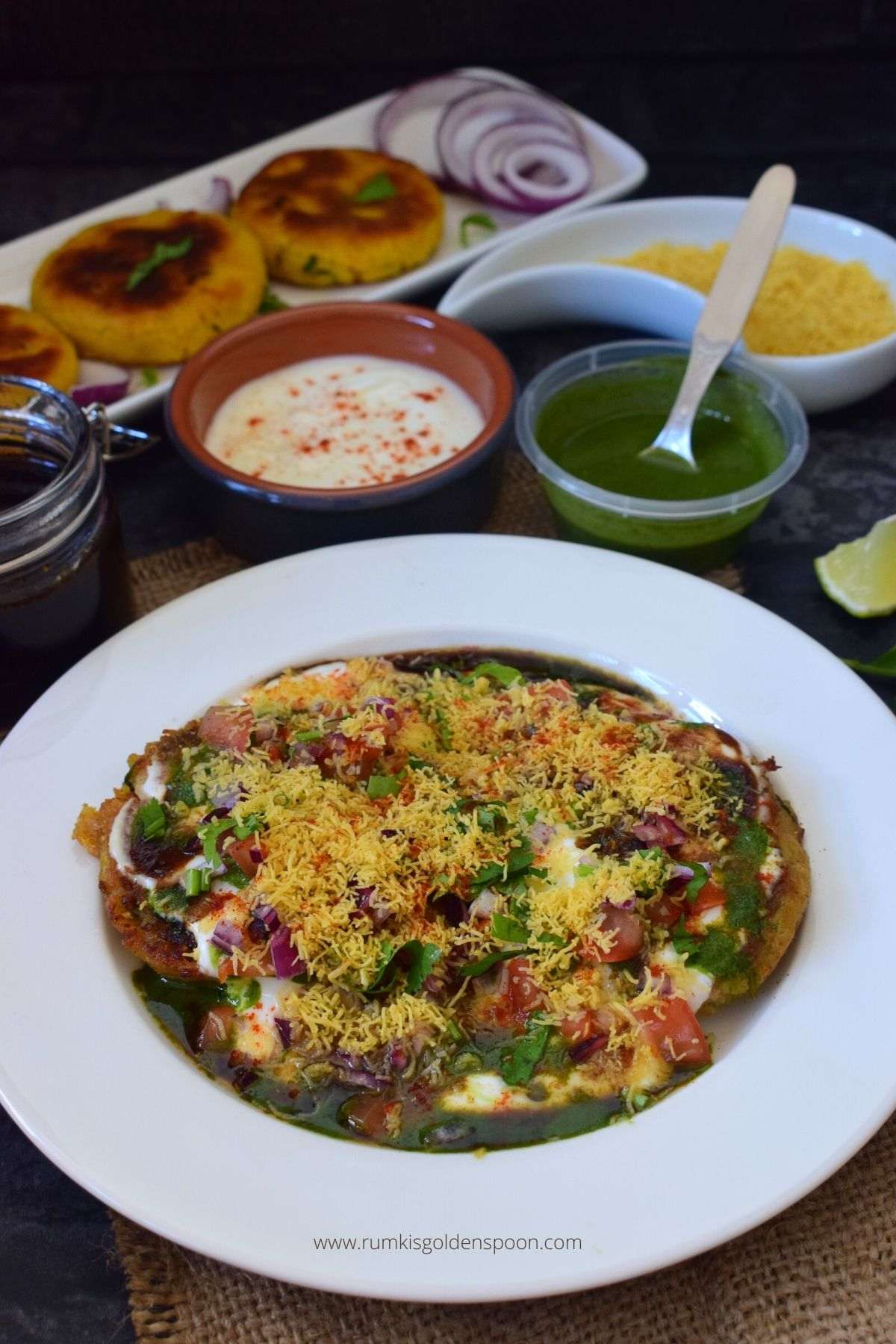
Ingredients:
1 cup = 250 ml
To prepare the lentil paste for dhoka
- 1 cup Chana dal aka Bengal gram
- 2 green Chillies
- 1½ teaspoon Sugar
- 1¼ teaspoon Salt
- ½ cup Water to make the paste
Rest of the ingredients to prepare dhoka
- ¼ cup grated Coconut
- 1 teaspoon Ginger paste
- ¼ teaspoon Hing aka asafoetida
- ½ teaspoon Turmeric powder
- ¾ teaspoon red Chilli powder
- ¾ teaspoon Cumin powder
- 2 tablespoons roasted Peanuts, crushed
- 2 tablespoons Oil
- Refined Oil to fry the dhoka
To prepare the slurry
- 1 tablespoon all-purpose Flour
- 2 tablespoons Water
For the spice paste
- 1 teaspoon Turmeric powder
- 1 teaspoon red Chilli powder
- 1½ teaspoon Cumin powder
- 1 teaspoon Coriander powder
- 2 tablespoons Water
To prepare dhokar dalna
- 2 Potatoes, medium diced
- 1 large Tomato, deseeded and diced
- 3-4 green Chillies
- ½ tablespoon Ginger paste
- 2 tablespoons grated Coconut
- ¼ teaspoon Cumin seeds (Jeera)
- 3 Cardamoms (Elaichi)
- 4 Cloves (Laung)
- 2 inches Cinnamon stick (Dalchini)
- 3 Bay leaves (Tejpatta)
- 2 dry red Chillies
- 2 teaspoons Sugar
- Salt to taste
- 1 teaspoon Bengali garam masala powder
- 1 teaspoon Ghee aka clarified butter
- 2 tablespoons Mustard oil
- 2¼ cups Hot water
Instructions:
- First wash 1 cup cholar dal aka chana dal a couple of times until the water gets clear and soak it in enough water for overnight or at least for 6 hours.
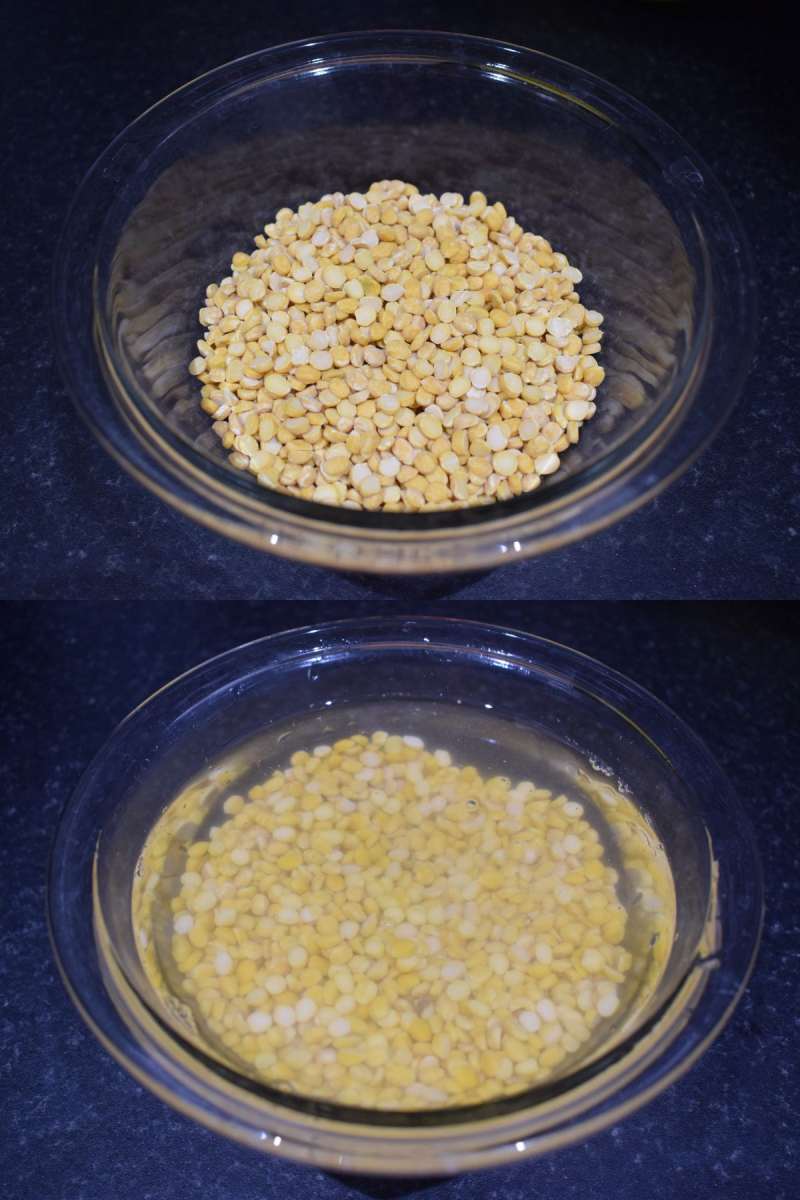
- Next day morning, drain the excess water and again wash the soaked dal once and drain the water.
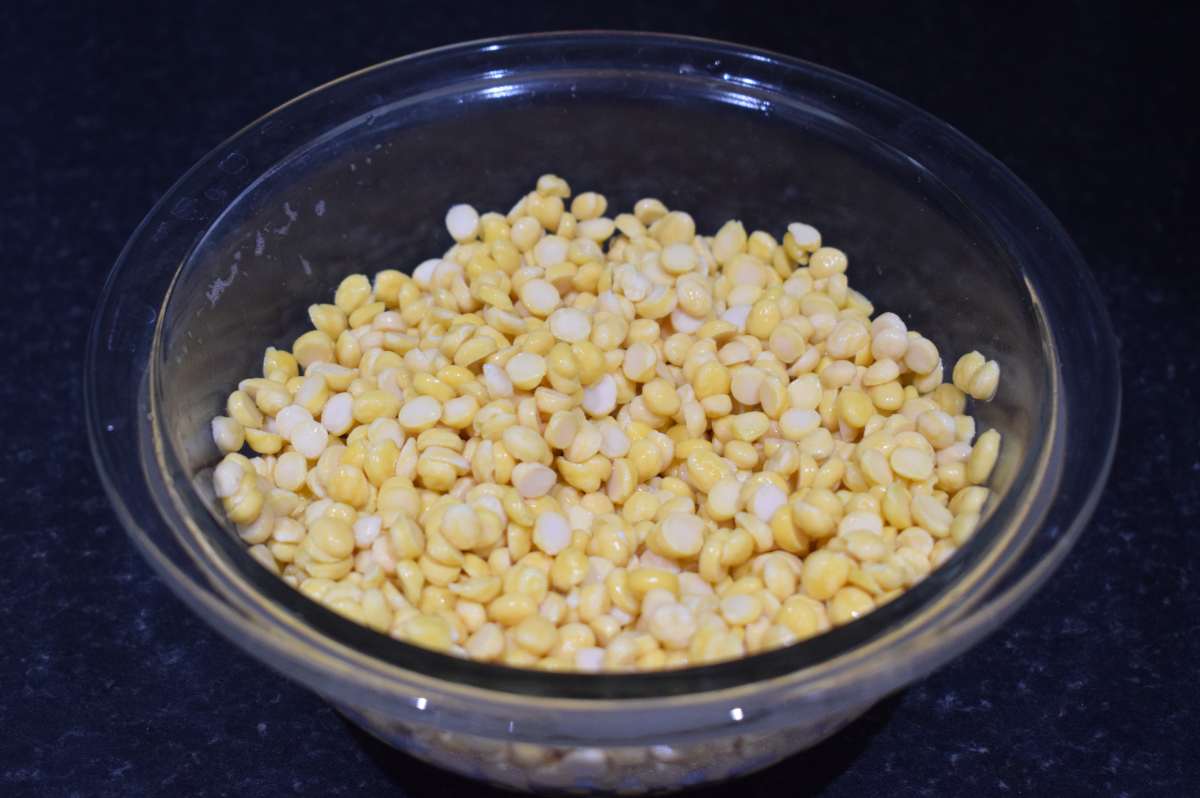
- Transfer the soaked dal into a jar of a grinder and add 2 green chillies, 1¼ teaspoons salt, 1½ teaspoons sugar, and ½ cup water, one by one into the jar. Close the lid of the jar and grind it to a smooth grain-free paste.
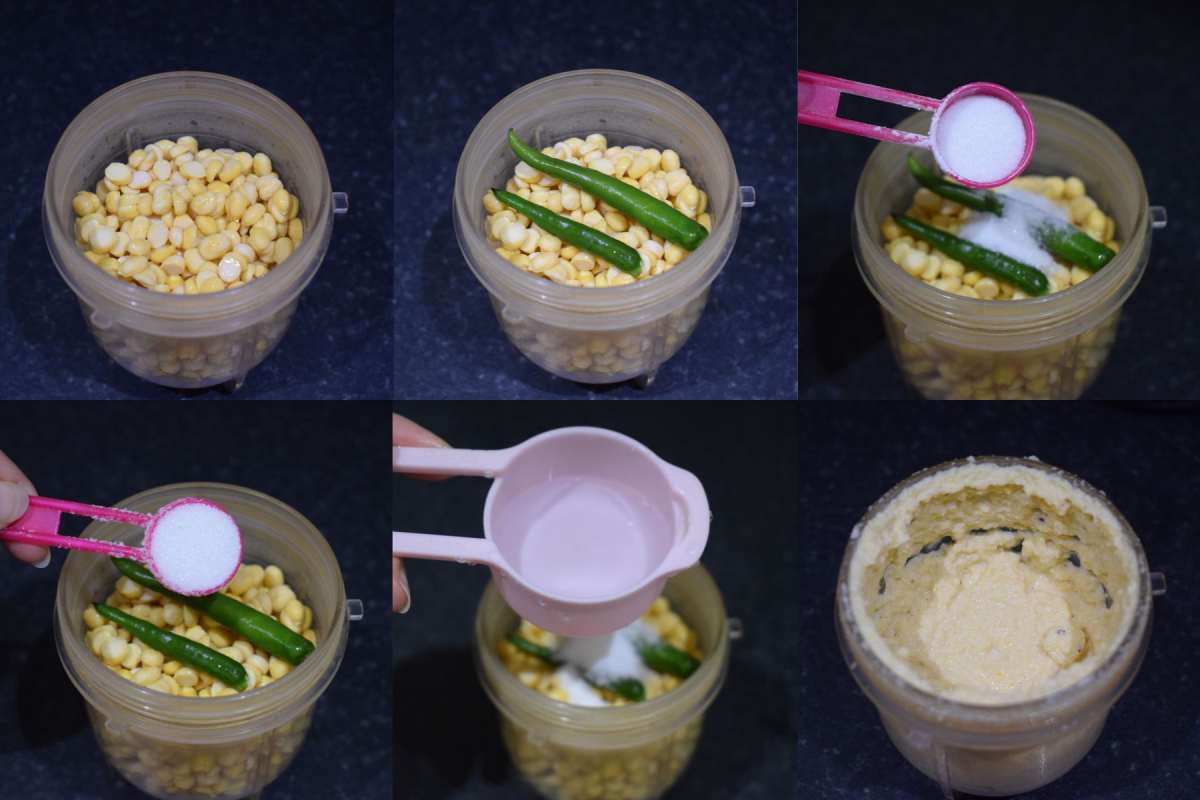
- Peel the skins of 2 tablespoons of roasted peanuts and transfer them to a mortar pestle and crush the peanuts roughly. Keep it aside for later use.
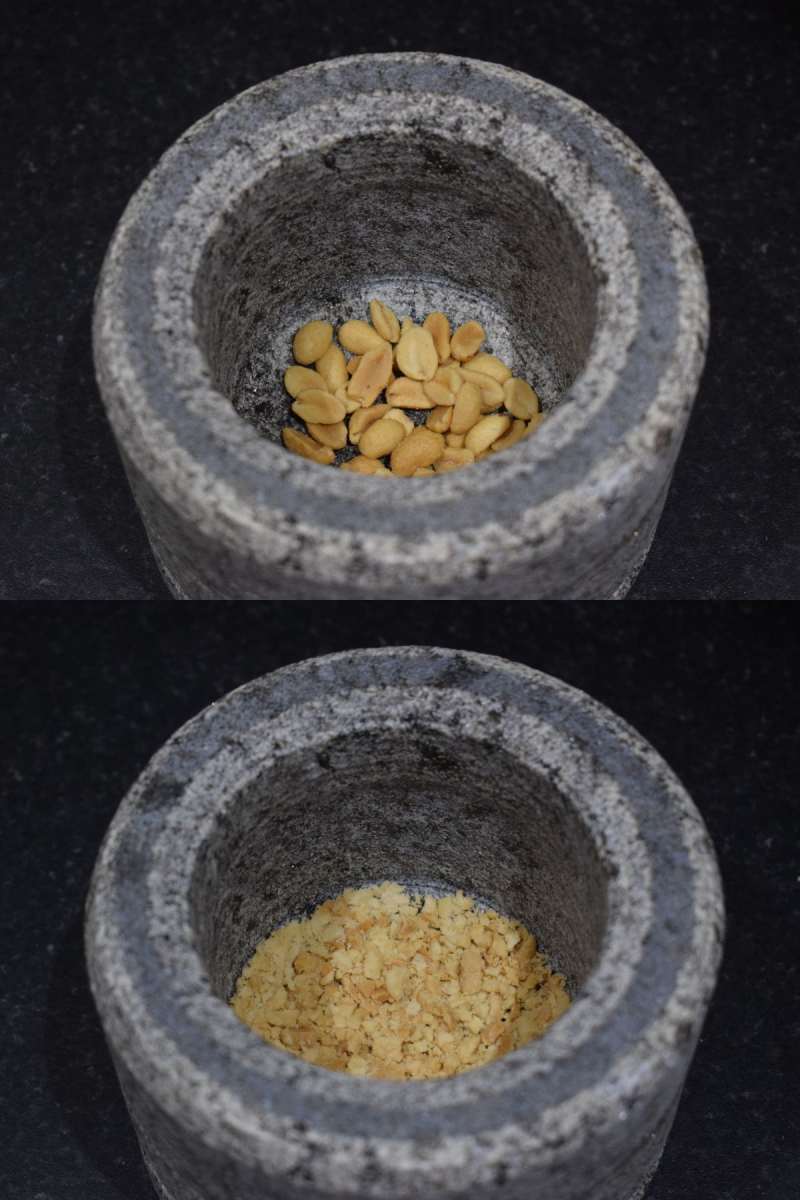
- Grease a portion of kitchen platform or a plate or tray and keep it handy for later use.
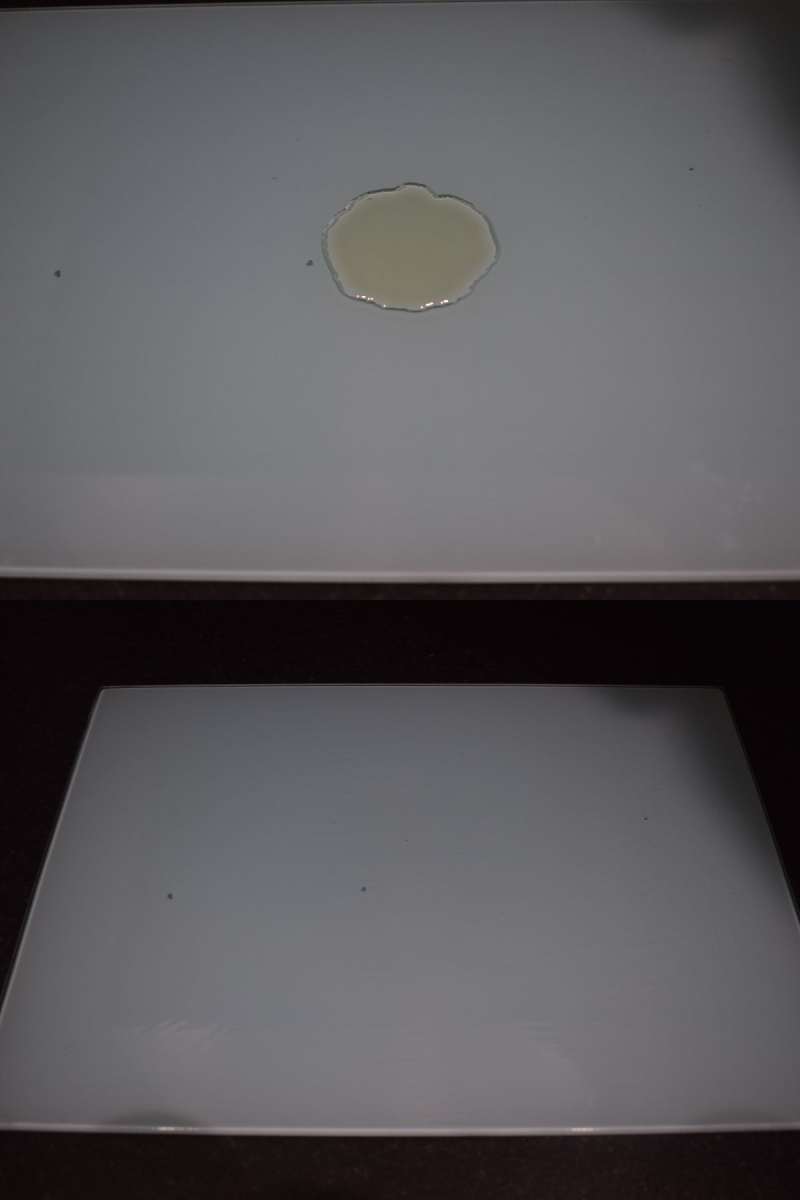
- Put a pan on flame and allow it to become completely dry. Add 2 tablespoons mustard oil into the pan and wait until the oil is hot. Generally, most of the traditional Bengali food is cooked in mustard oil. It gives an outstanding flavor to the dish.
- Turn the flame low and add ¼ cup grated coconut, 1 teaspoon ginger paste into it. Stir it frequently until the coconut turns light golden in colour and the raw smell goes away.
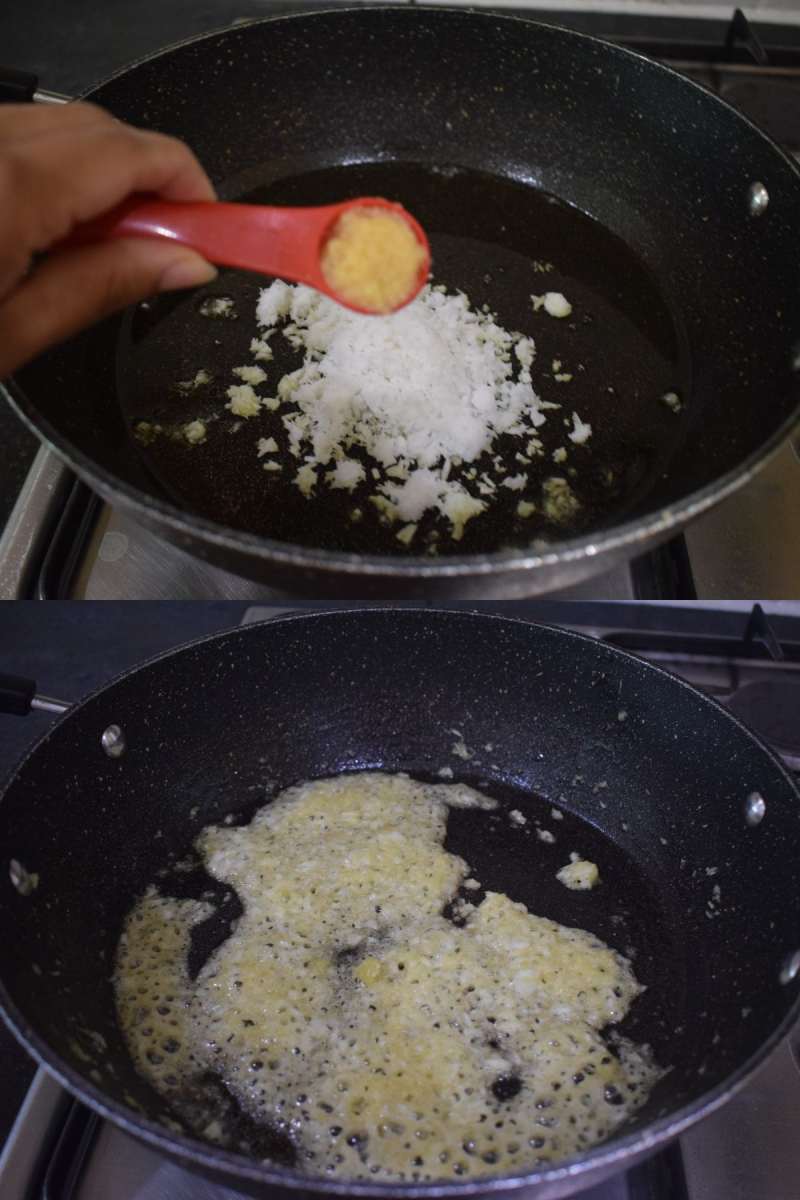
- Add ½ teaspoon turmeric powder, ¾ teaspoon red chilli powder, ¾ teaspoon cumin powder, and ¼ teaspoon hing aka asafoetida, one by one into the pan and cook it on low flame for another minute until the raw smell goes away.
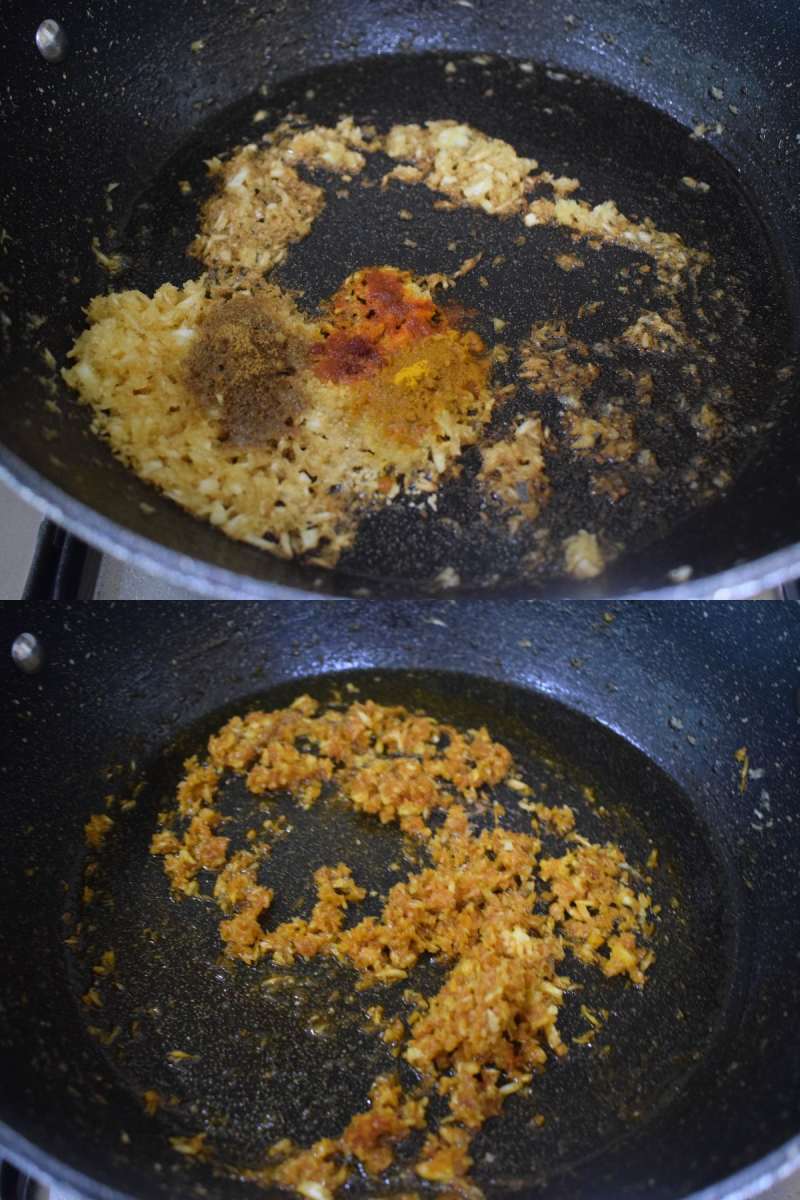
- Add the lentil paste into the pan and cook it in low flame for 5 minutes until the excess water evaporates. Stir continuously.
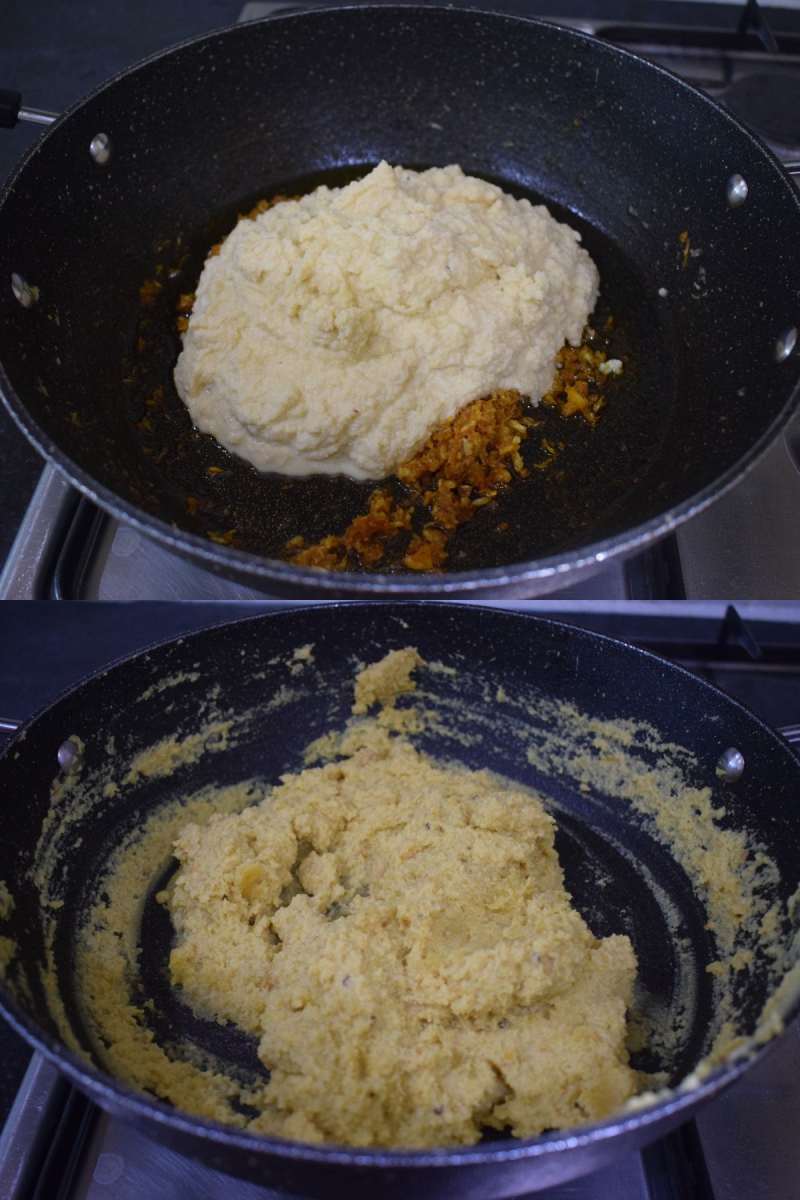
- Add the crushed peanuts (Step 4) into the pan and mix it well. Stir the content continuously and scrap the sides and bottom of the pan to prevent sticking. Cook it until the content changes its colour and turns into a mass. It takes around another 5-6 minutes. In the final stage, the content becomes tight and needed to put much effort to stir it.
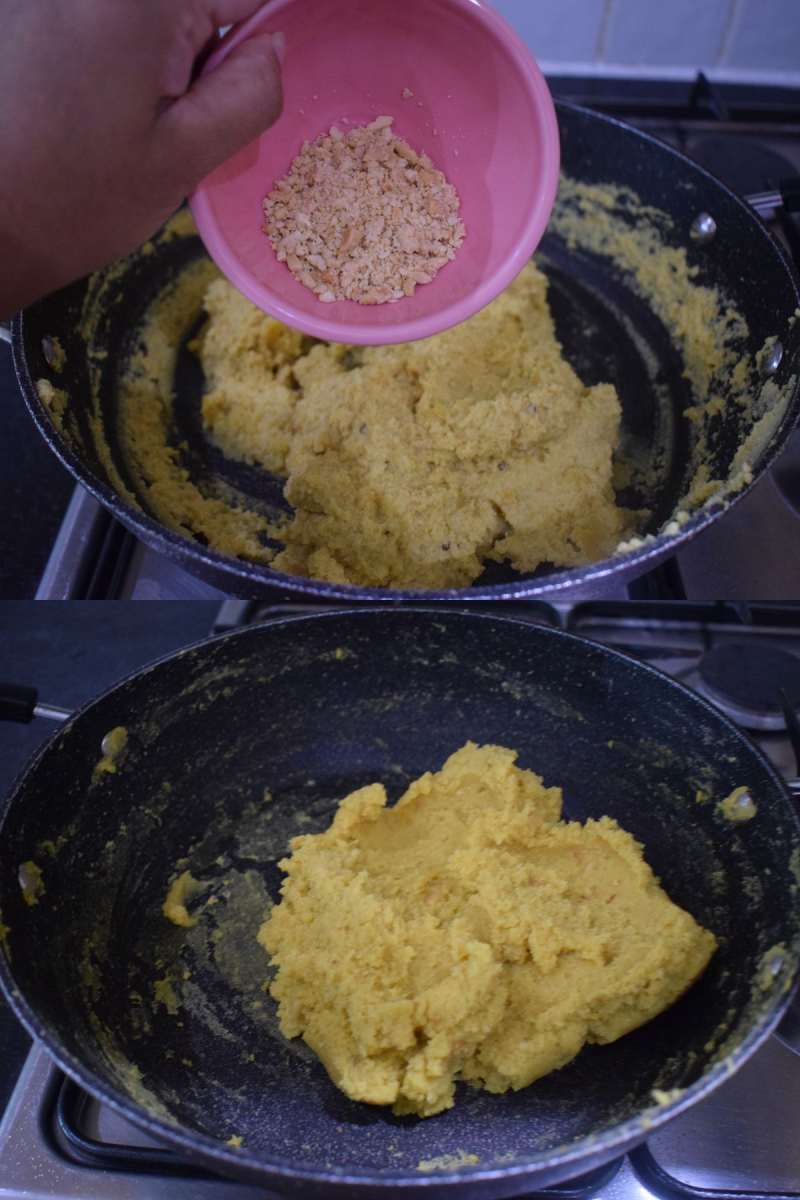
- Transfer the lentil mass immediately to the greased flat surface (Step 5) and flatten it around 2 cm thick. Gather the sides and make them smooth.
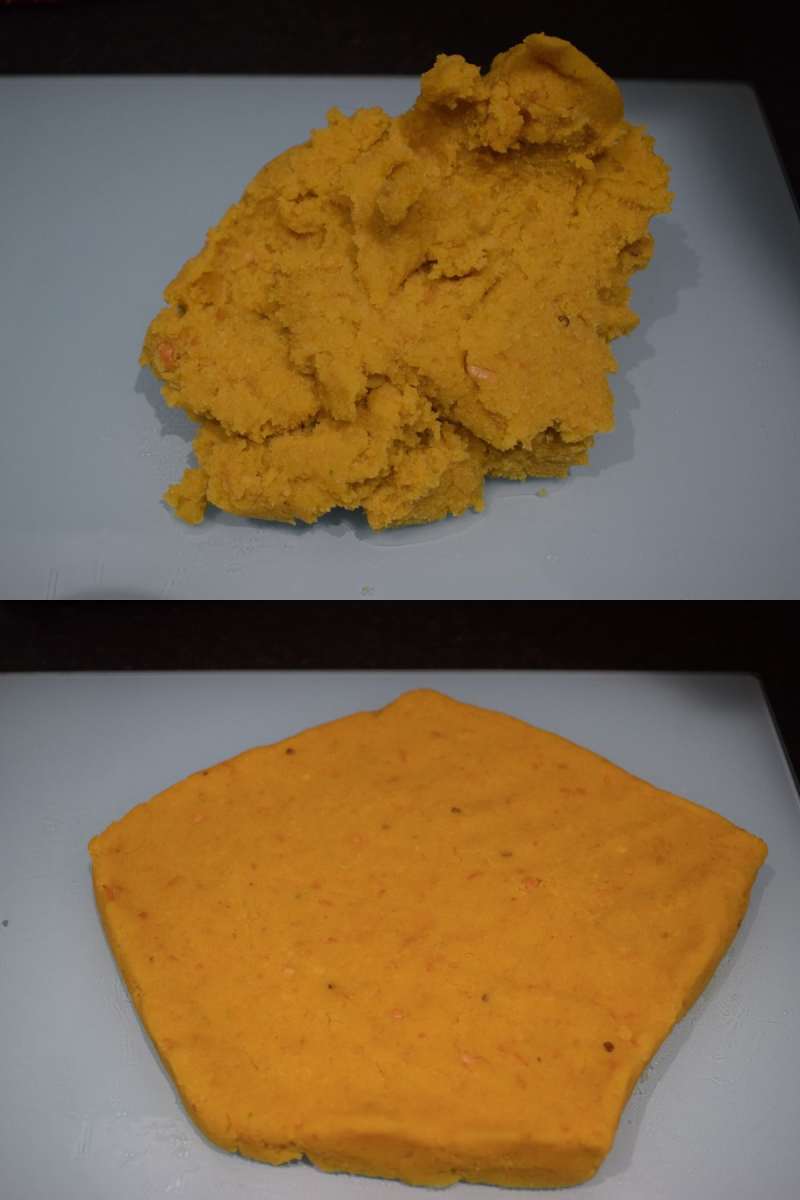
- Now cut it into diamond or square shapes. Allow it to cool down.
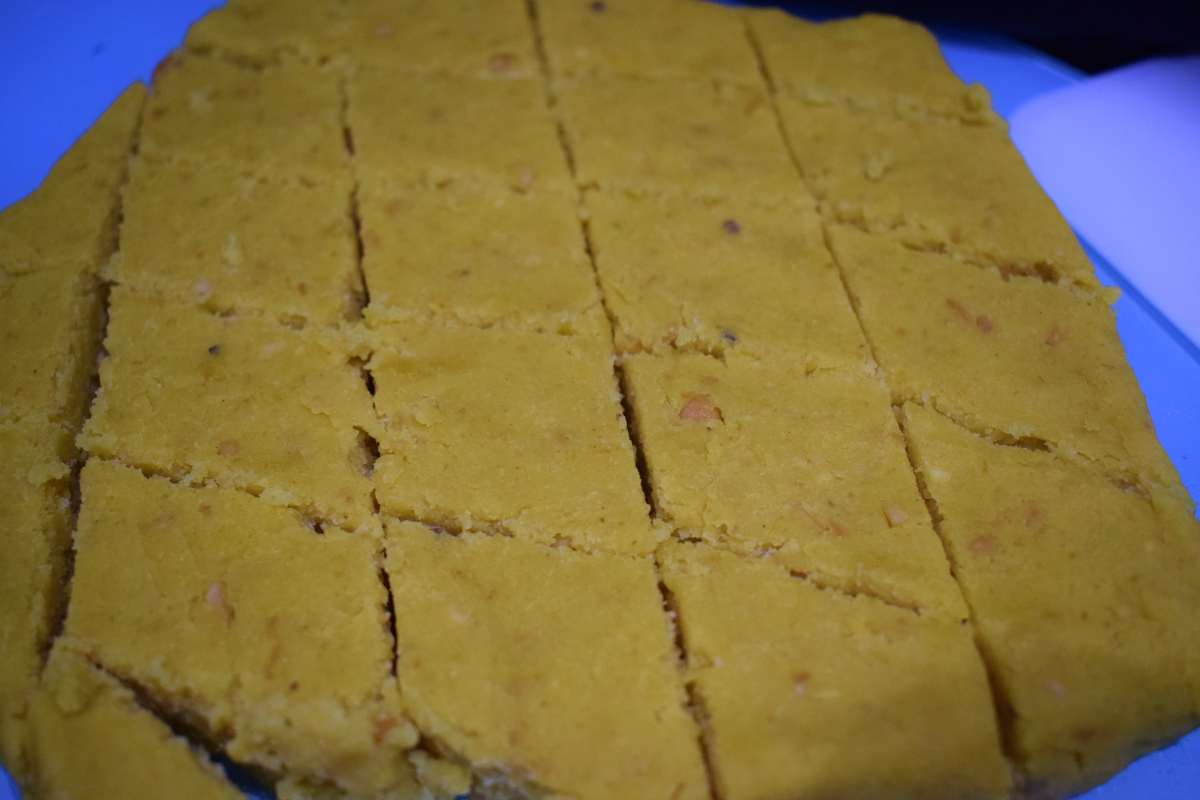
- Take a small bowl and add 1 tablespoon all-purpose flour and 2 tablespoons of water into it. Mix it nicely and make a slurry.
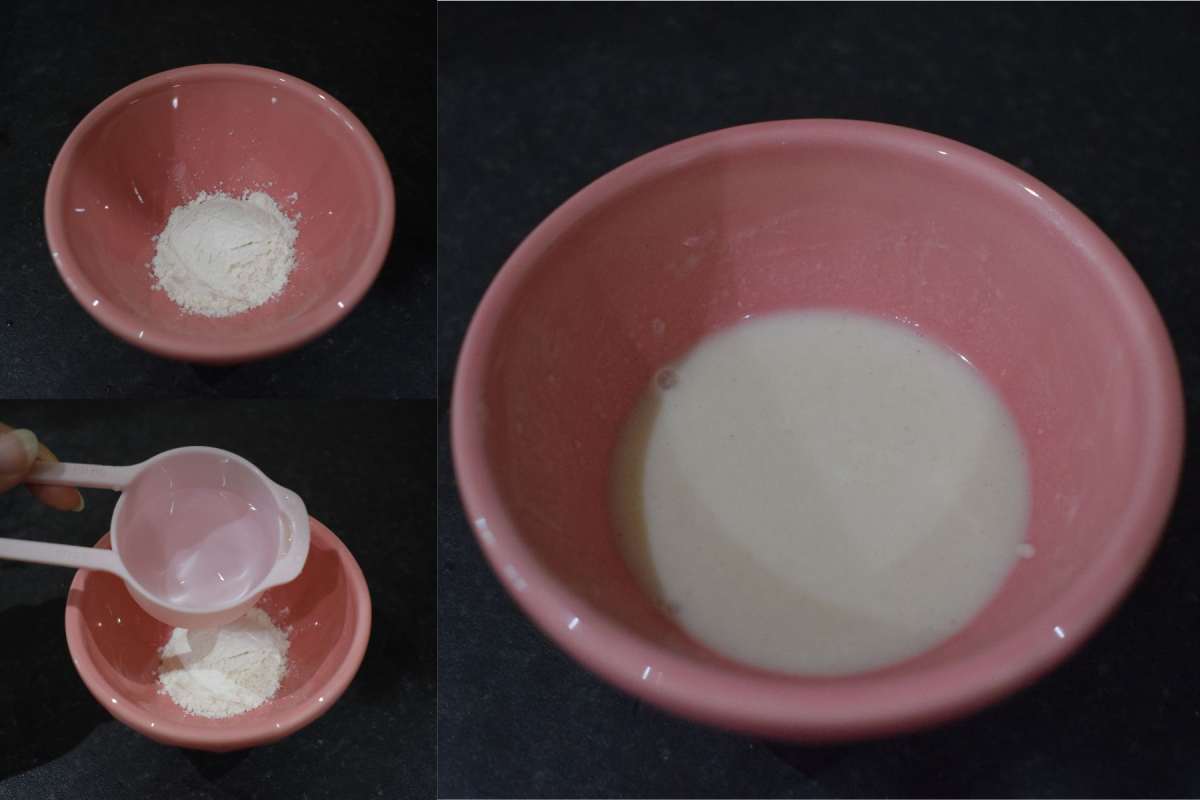
- Seal the crumbles of the sides with the slurry and make each piece intact.
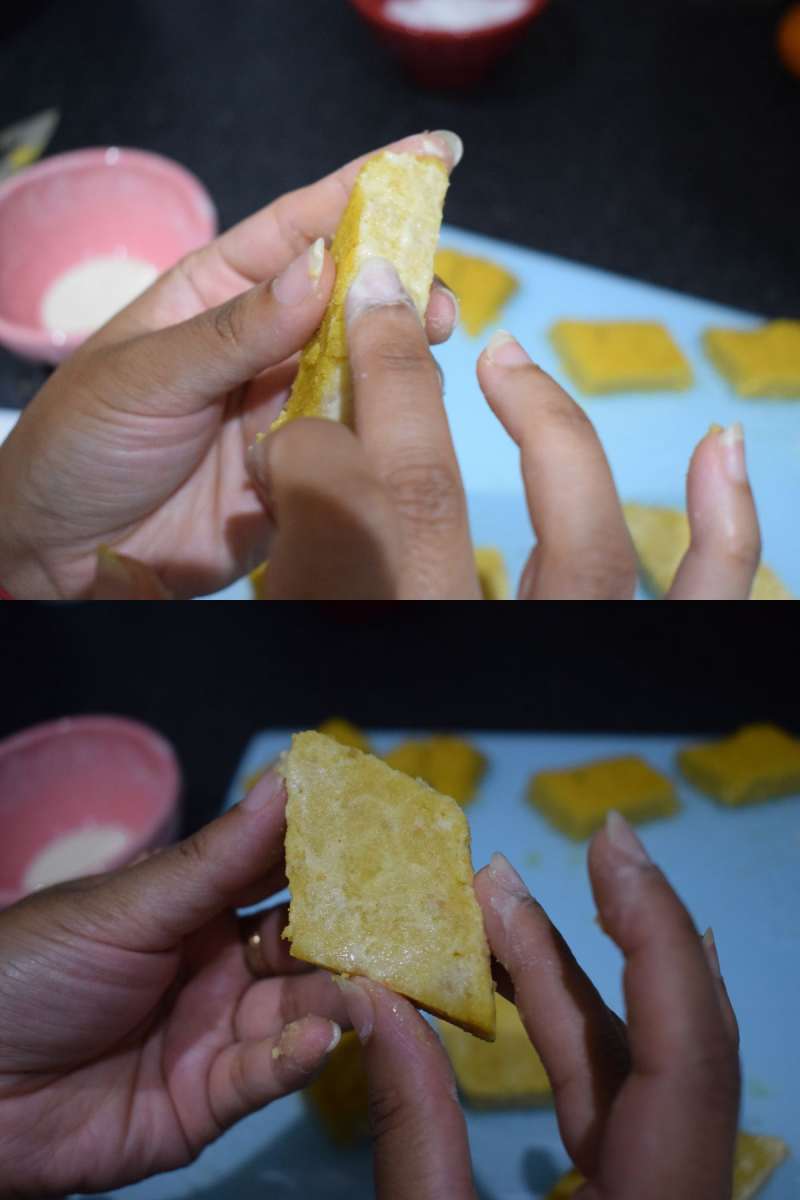
- On the other hand, put a pan on flame and allow it to become completely dry. Add enough oil to fry the dhoka.
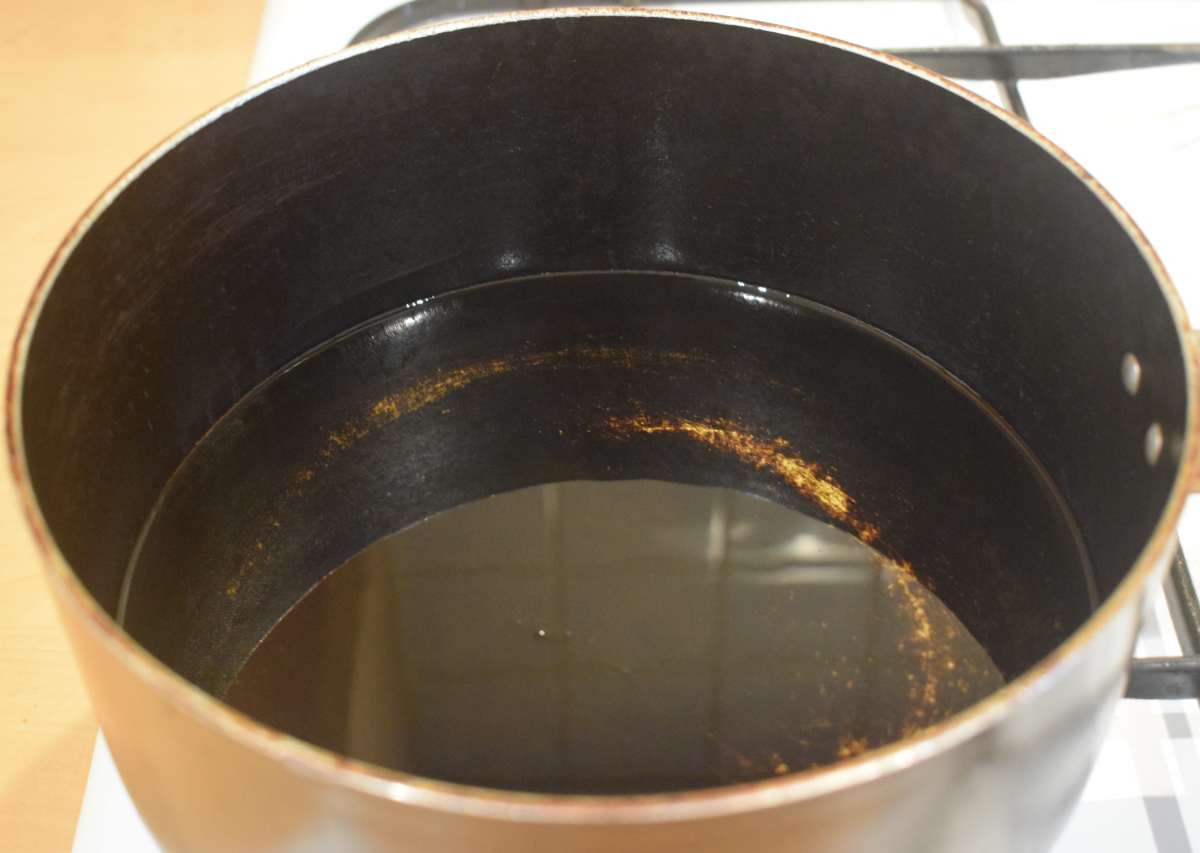
- Once the oil is hot, turn the flame to medium and carefully add the diamond-shaped dhoka into the hot oil in small batches. Once the bottom side of the dhoka turns golden brown, flip it very carefully and fry the other side.
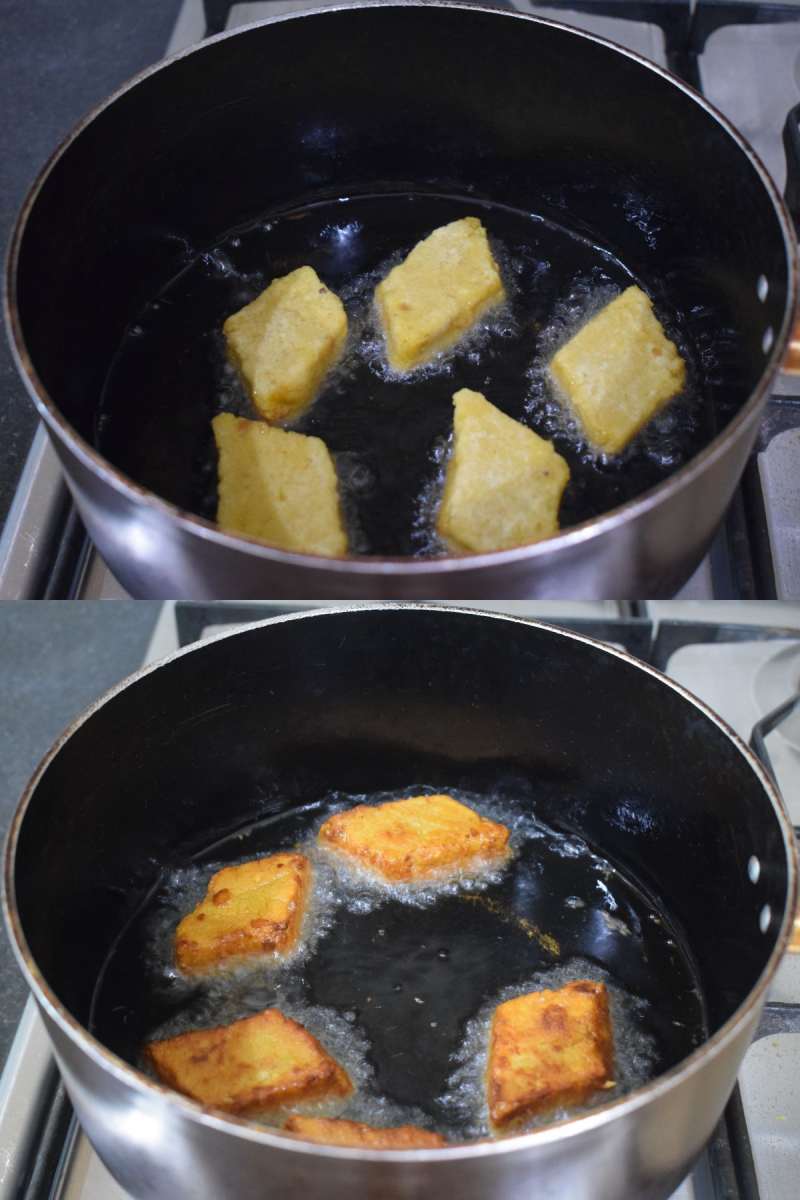
- Put the flame on low and strain out the dhoka from the hot oil and transfer them to a plate.
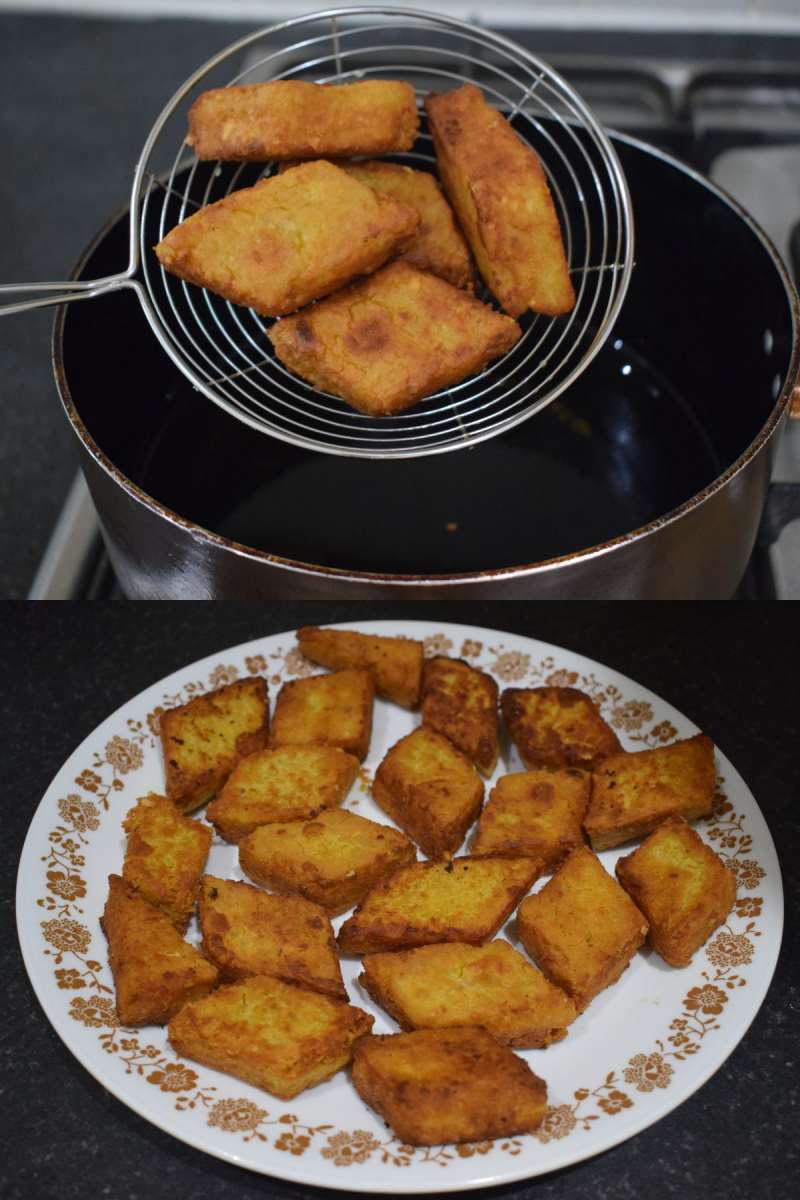
- Put a pan on flame and allow it to become completely dry. Add 2 tablespoons mustard oil into the pan and wait until the oil is hot.
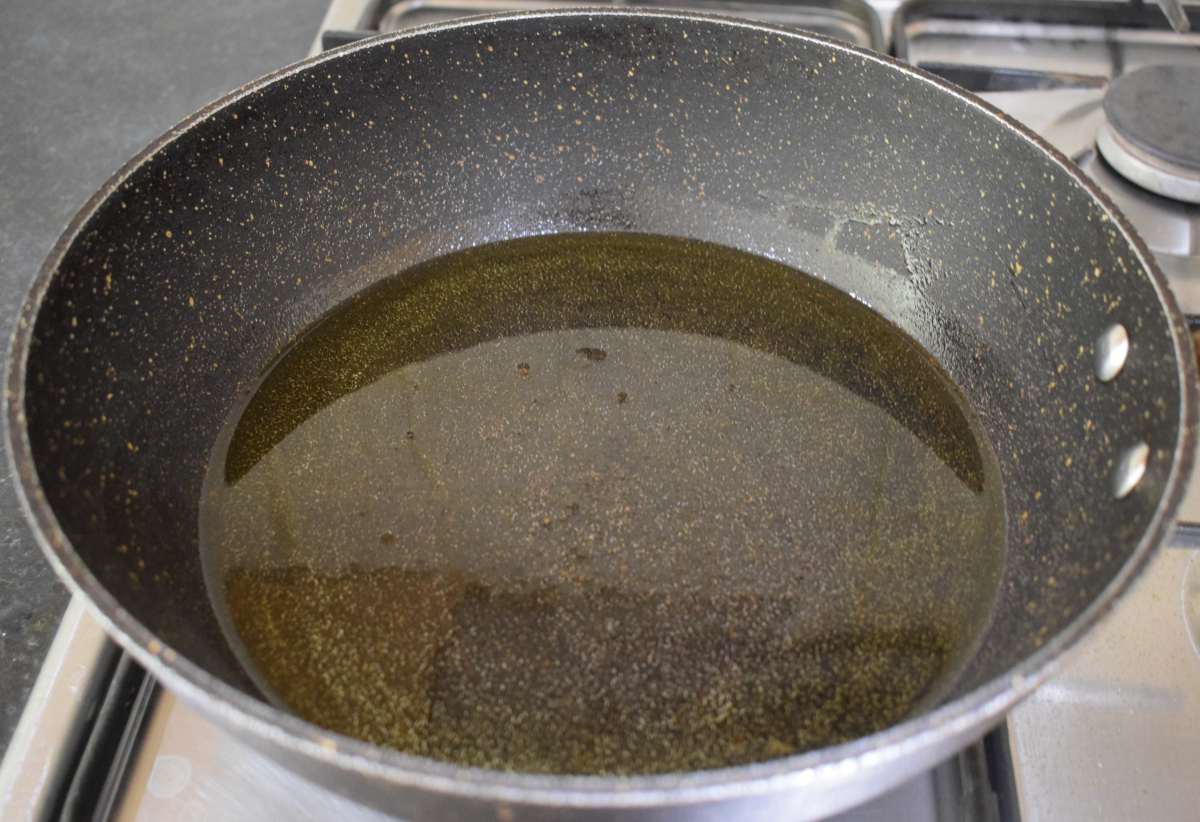
- Add whole spices 3 bay leaves, 2 dry red chillies, 4 cloves, 2 inches cinnamon stick, 3 cardamoms, ¼ teaspoon cumin seeds and let them crackle. Then turn the flame low and add ¼ teaspoon hing aka asafetida into it.
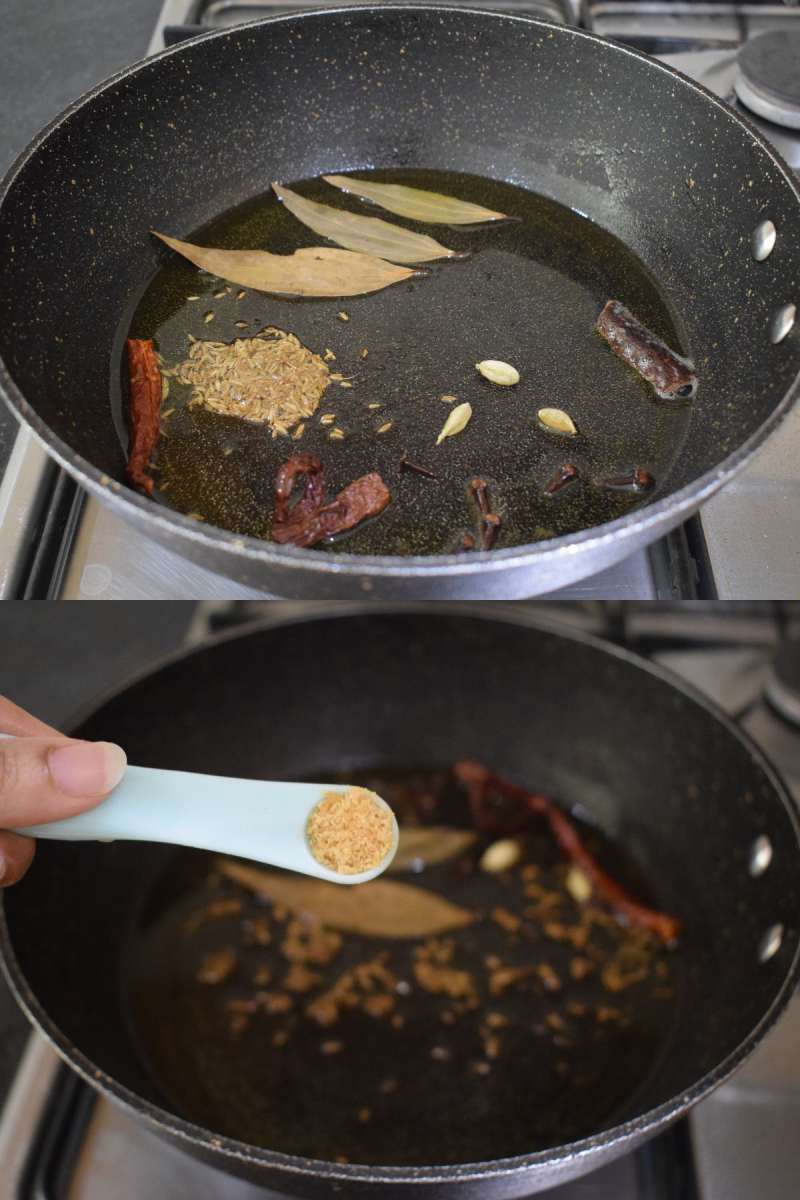
- Add potato chunks into the pan and give a nice mix. Cook it on medium flame for a couple of minutes.
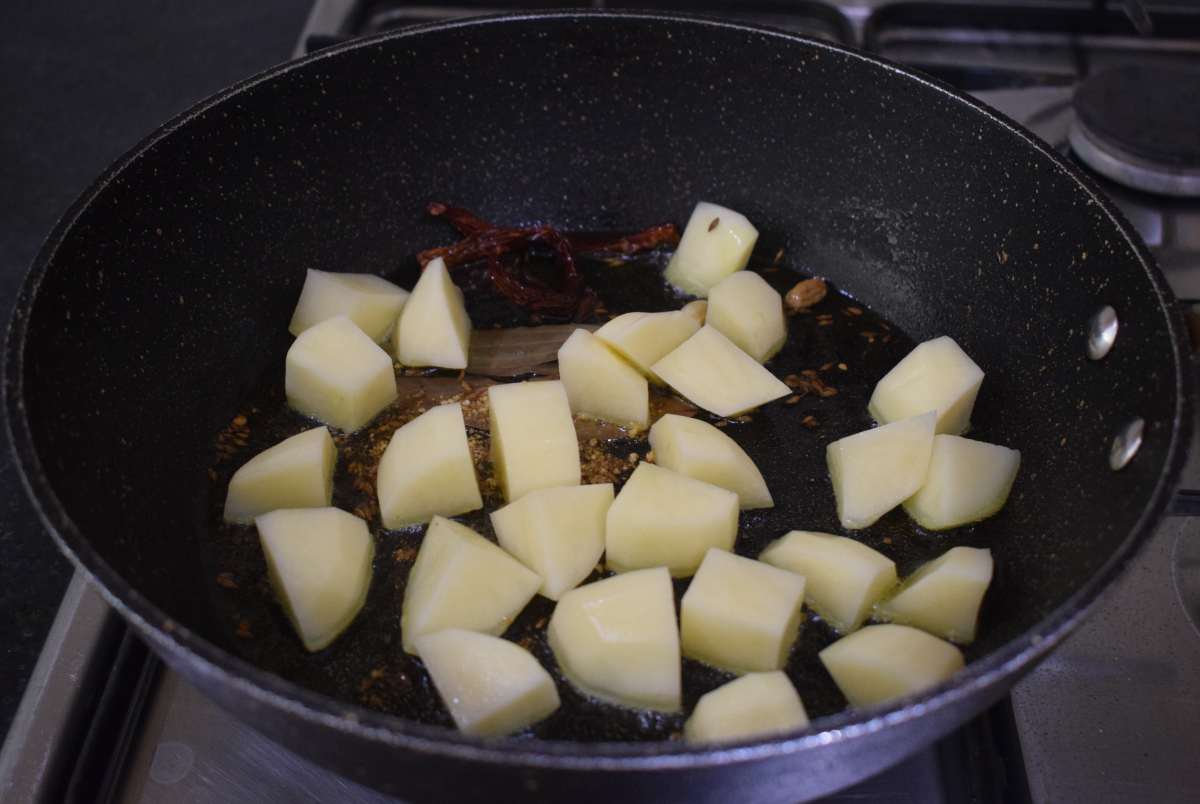
- Add ½ tablespoon ginger paste and mix it well. Cook it on low flame until the raw smell goes away.
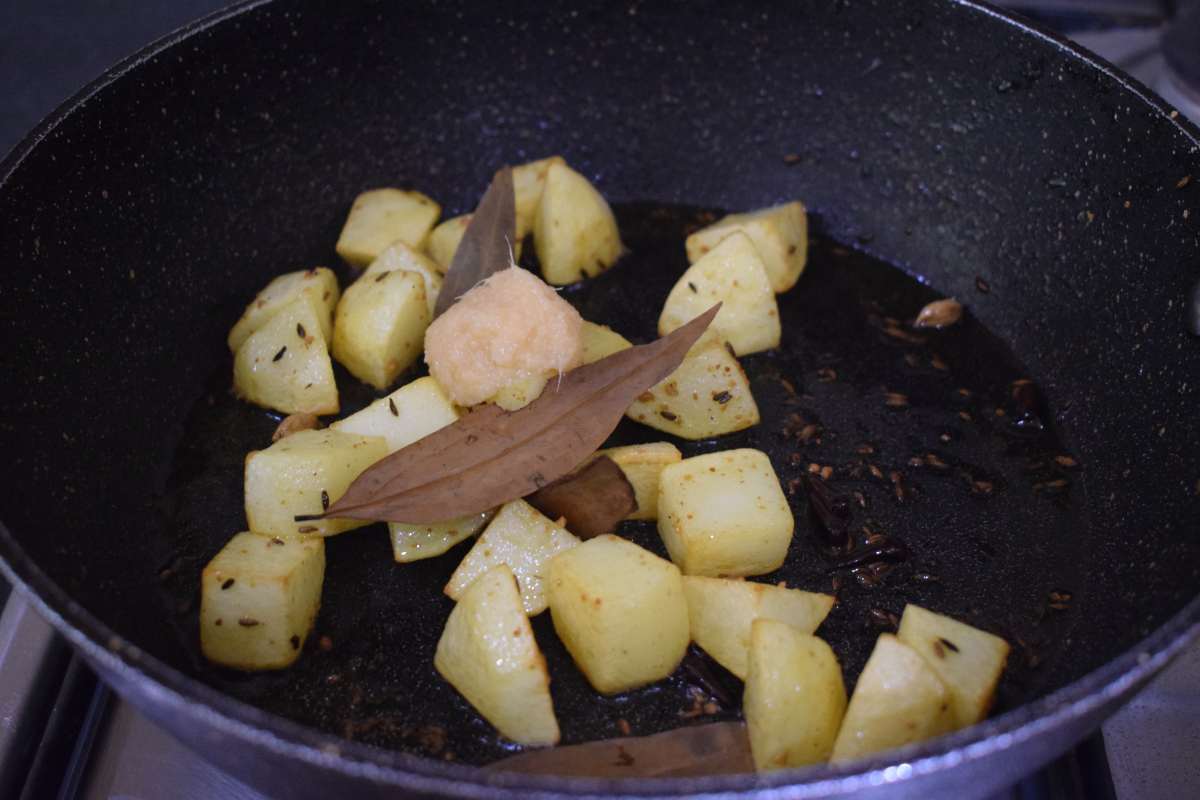
- Add 2 tablespoons of grated coconut and cook it on low flame for 1-2 minutes until the raw smell goes away.
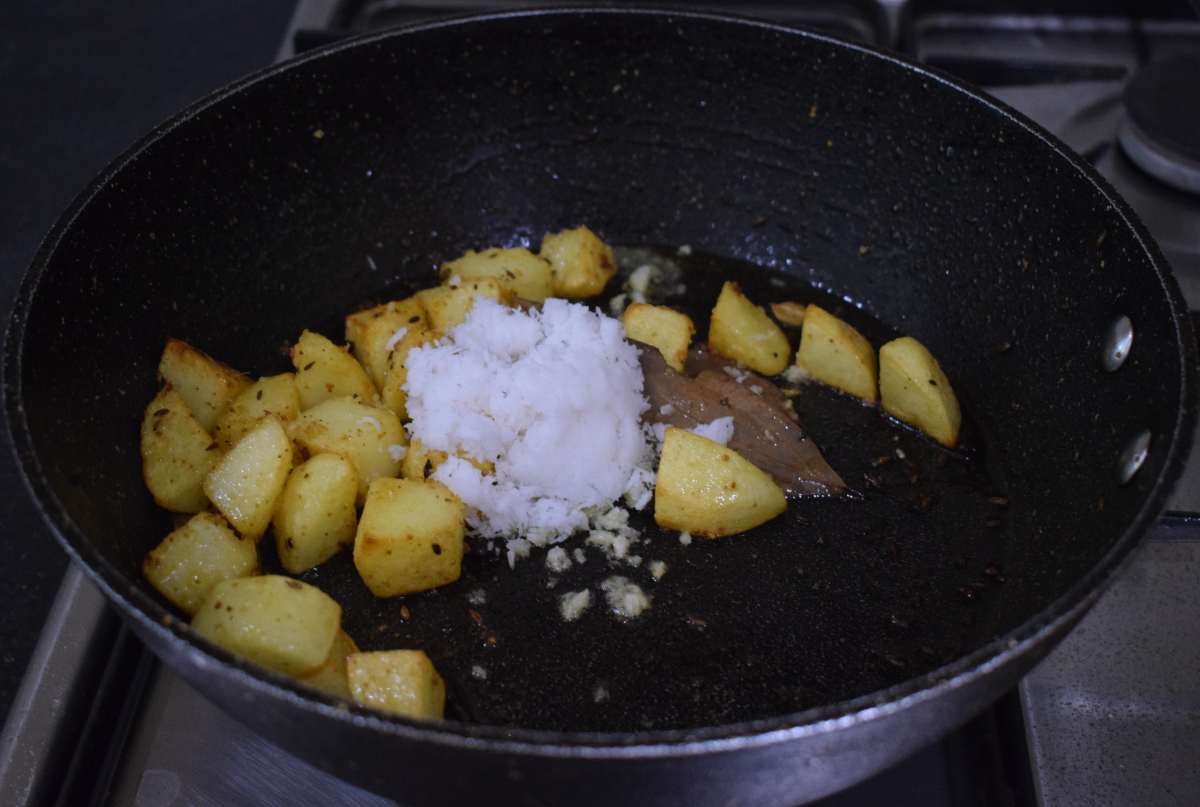
- Add chopped tomato, 3-4 green chillies into the pan and give a nice stir. Cover the pan and cook on medium to low flame for 5 minutes until the tomatoes get mushy and the potatoes get cooked.
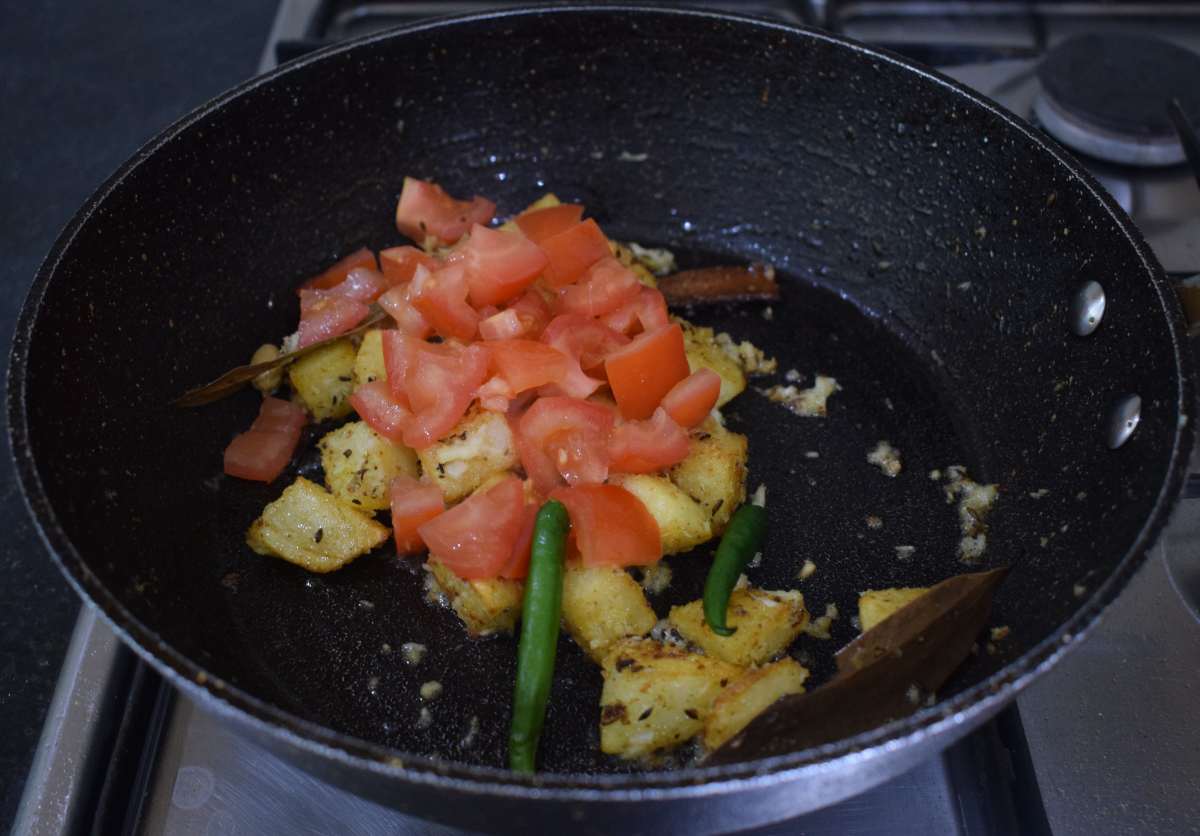
- In the meantime, take a bowl and add 1 teaspoon turmeric powder, 1 teaspoon red chilli powder, 1½ teaspoon cumin powder, 1 teaspoon coriander powder and 2 tablespoons of water into it. Mix it thoroughly and make a paste of the spices.
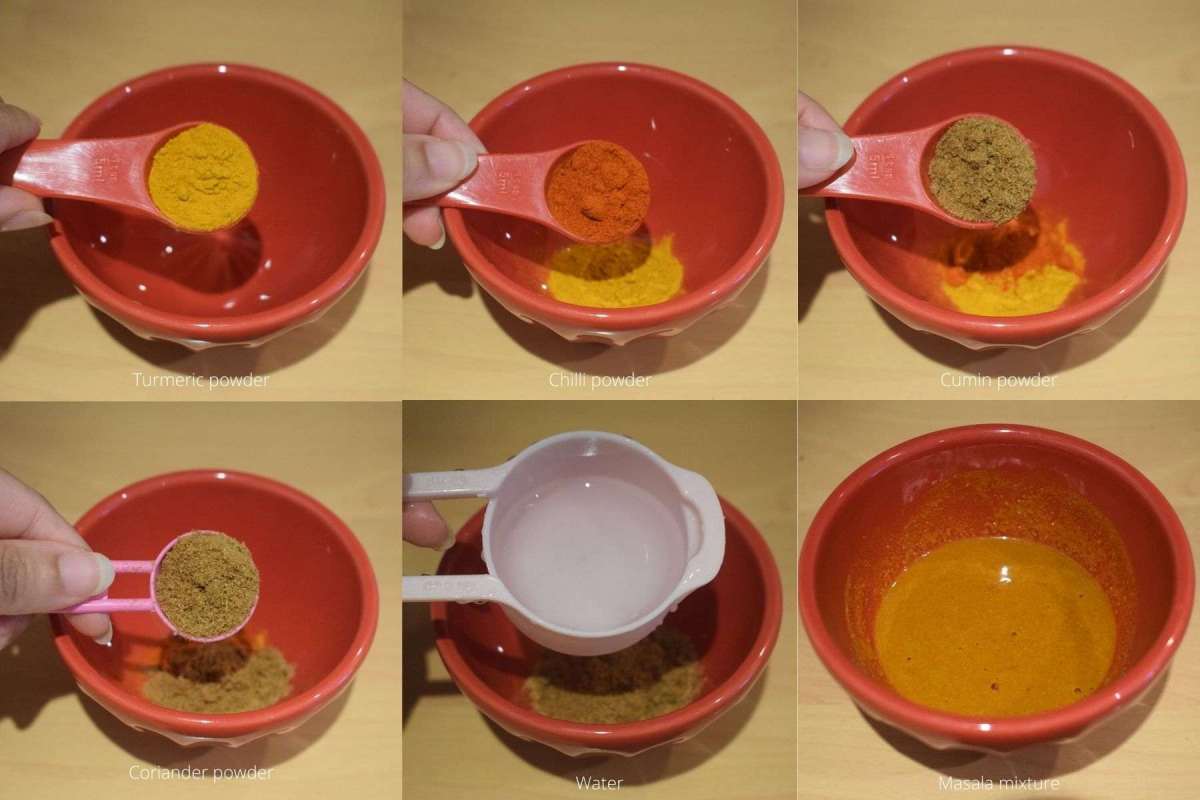
- Add the masala paste into the pan and mix it well. Cook it on low flame for another 2-3 minutes so the masala can get cooked properly.
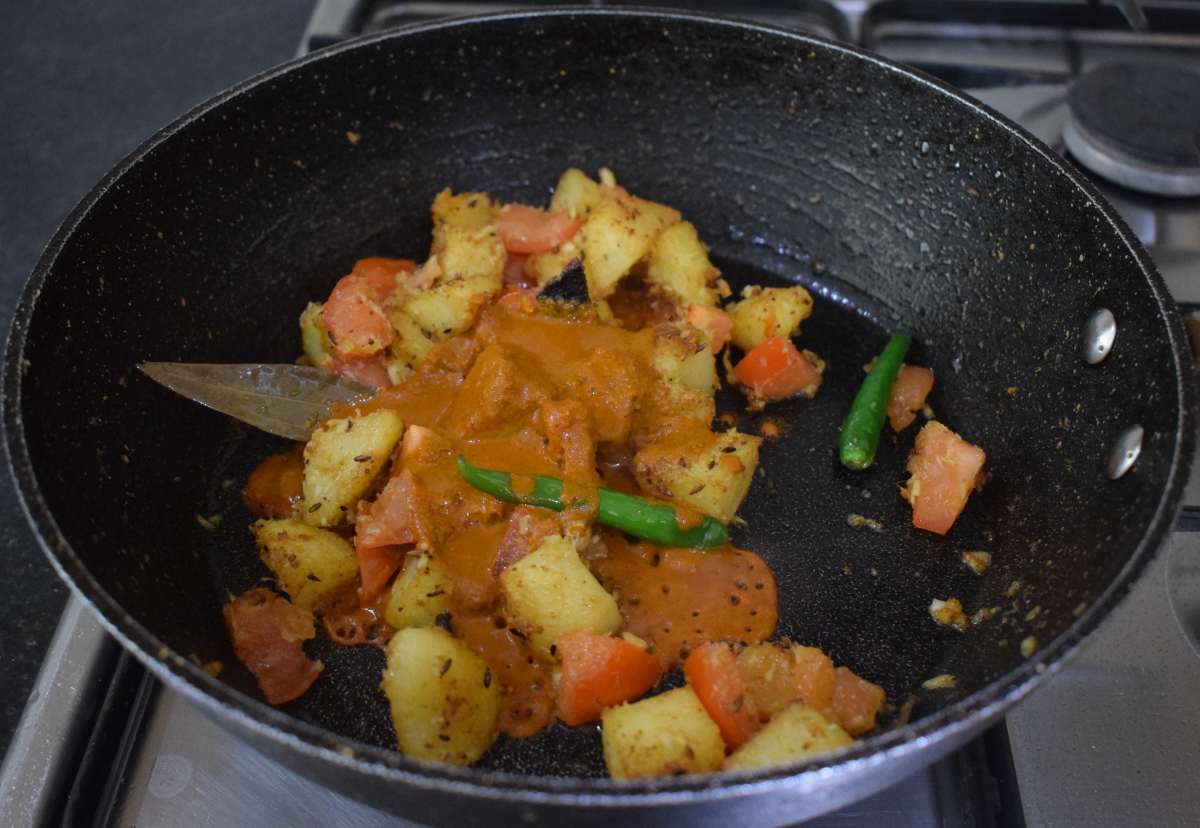
- Add salt, 2 teaspoons of sugar into the pan and give a nice mix.
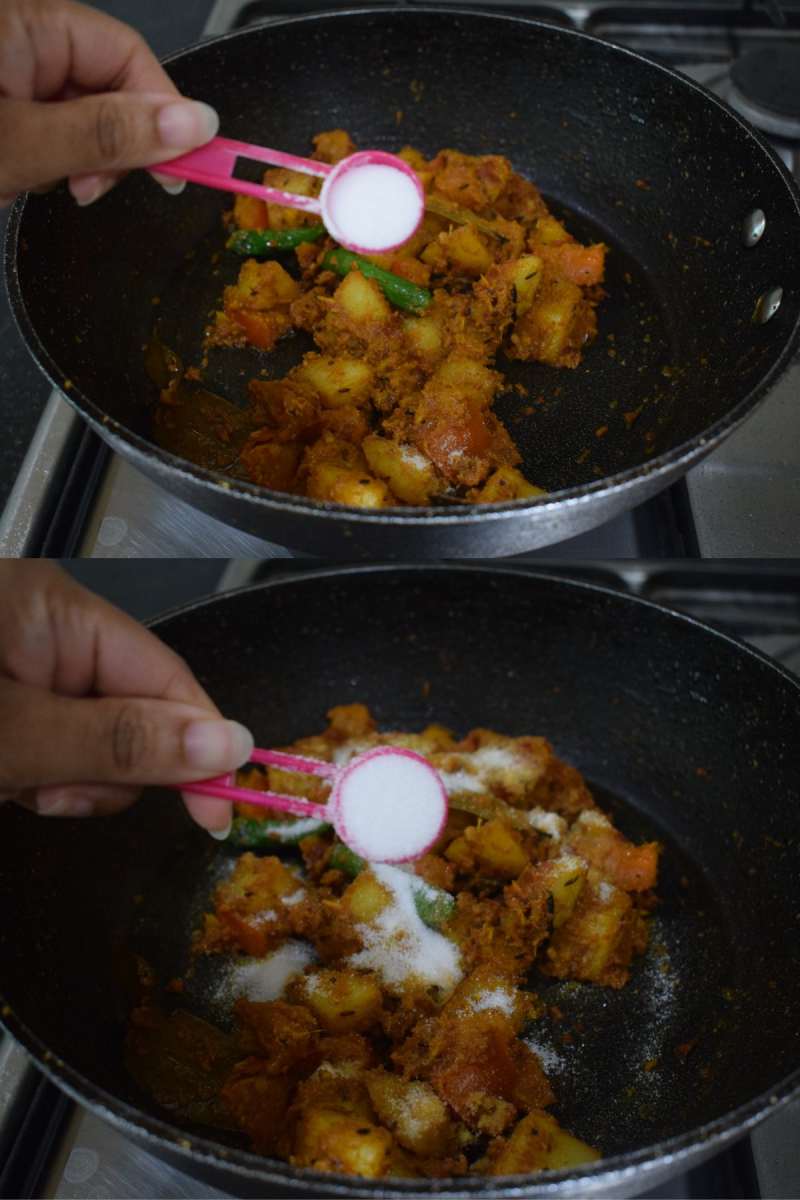
- Add 2¼ cups hot water into the pan and give a nice stir. Cover the pan and put the flame on high until the gravy starts boiling.
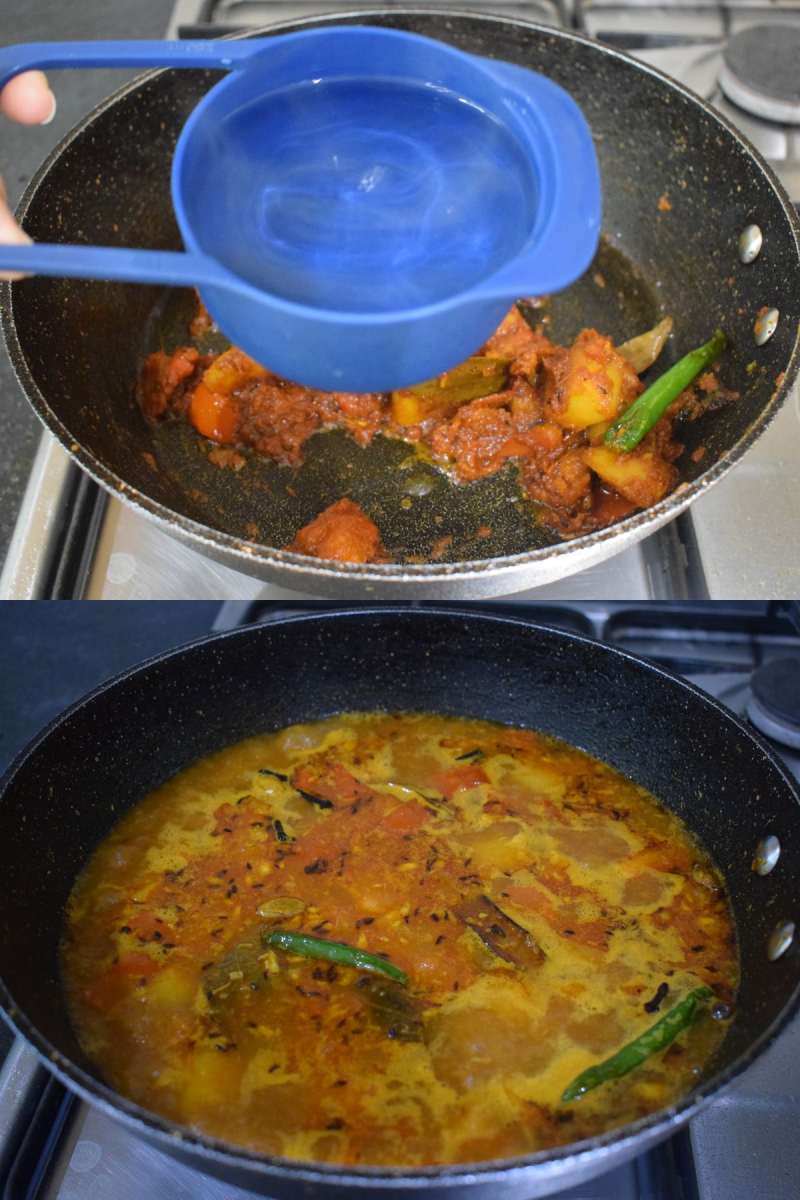
- Put the flame to low and add the fried dhoka into the pan. Cook it on medium-low flame for 3-4 minutes but not more than that.
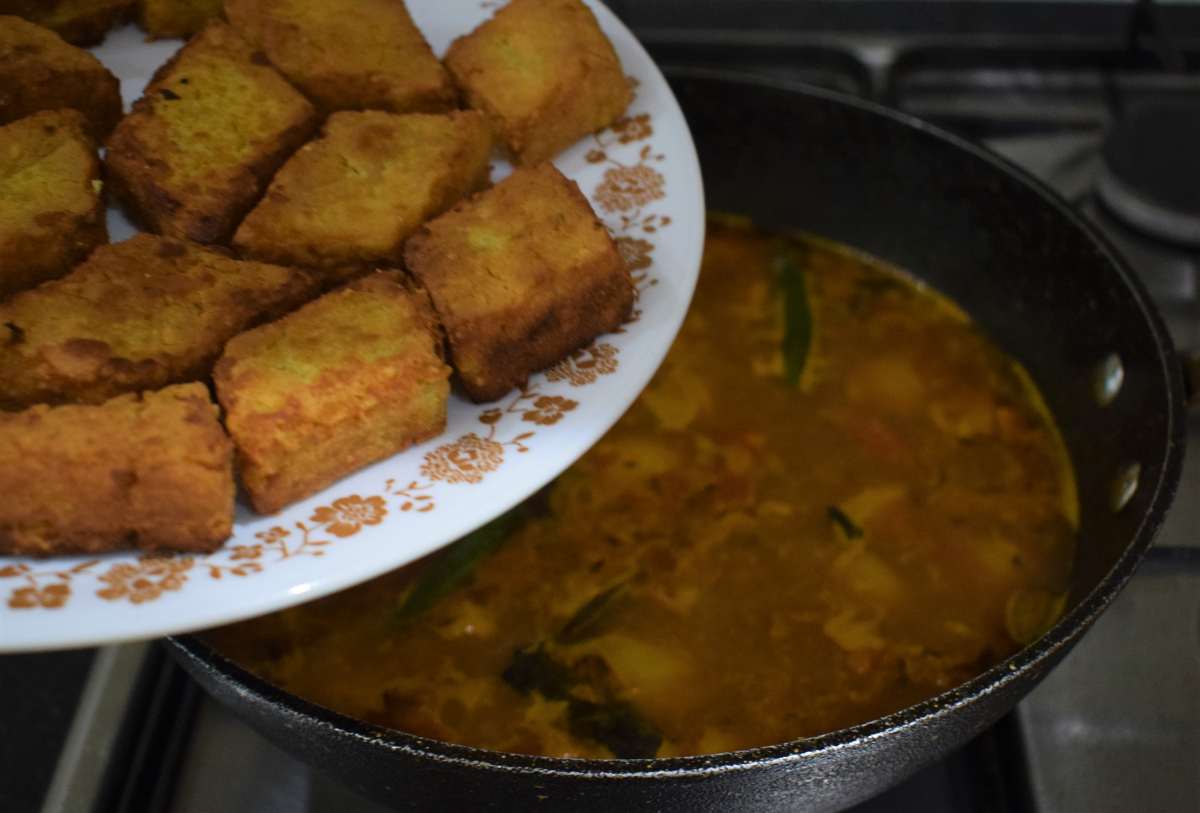 Note: The consistency of the dhokar dalna gravy is slightly runny. Later the dhoka will absorb the gravy and it will turn slightly thick.
Note: The consistency of the dhokar dalna gravy is slightly runny. Later the dhoka will absorb the gravy and it will turn slightly thick. - At the final stage of cooking, add 1 teaspoon bengali garam masala powder and 1 teaspoon ghee aka clarified butter, one by one into the pan. These spices complement the flavour of the dish very well.
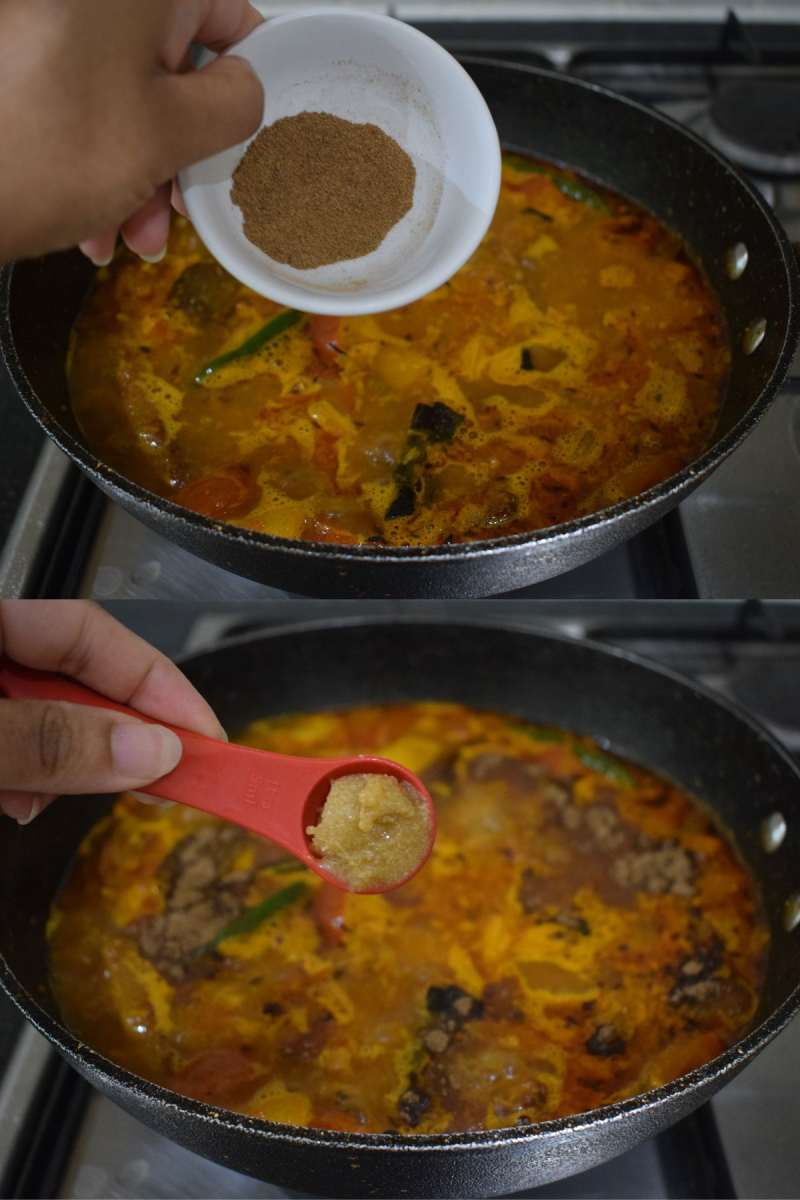
- Check the salt of the curry and add if required. Simmer the gravy for 10-15 more seconds and then switch off the flame.
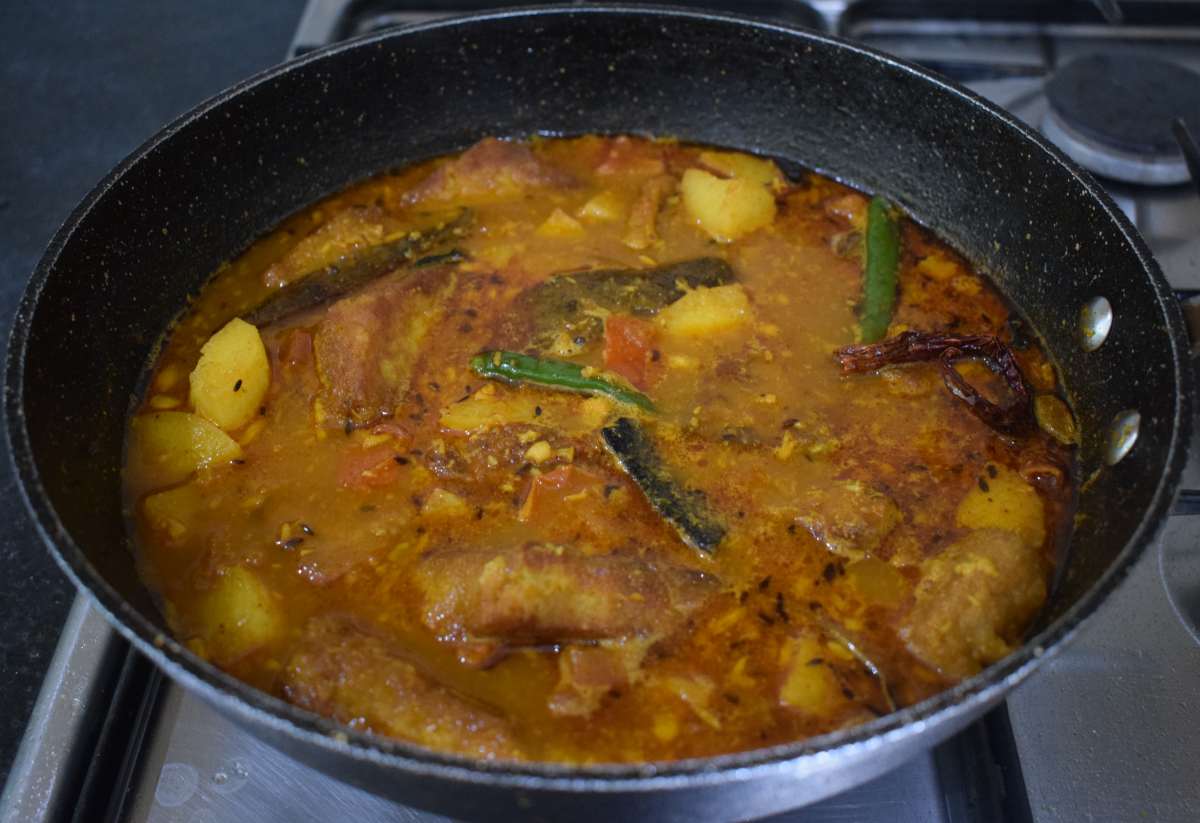
Serving Instruction
Serve the Aloo tikki chaat recipe immediately to enjoy the perfect crisp of the potato tikkis. Enjoy the salivating Indian veg snack recipe with your family and friends with lots of gossips.
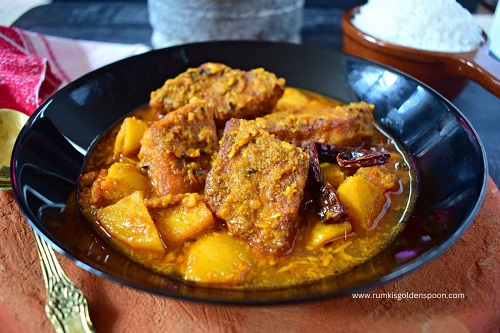
Ingredients
1 cup = 250 ml
To prepare the lentil paste for dhoka
- 1 cup Chana dal aka Bengal gram
- 2 green Chillies
- 1½ teaspoon Sugar
- 1¼ teaspoon Salt
- ½ cup Water to make the paste
Rest of the ingredients to prepare dhoka
- ¼ cup grated Coconut
- 1 teaspoon Ginger paste
- ¼ teaspoon Hing aka asafoetida
- ½ teaspoon Turmeric powder
- ¾ teaspoon red Chilli powder
- ¾ teaspoon Cumin powder
- 2 tablespoons roasted Peanuts, crushed
- 2 tablespoons Oil
- Refined Oil to fry the dhoka
To prepare the slurry
- 1 tablespoon all-purpose Flour
- 2 tablespoons Water
For the spice paste
- 1 teaspoon Turmeric powder
- 1 teaspoon red Chilli powder
- 1½ teaspoon Cumin powder
- 1 teaspoon Coriander powder
- 2 tablespoons Water
To prepare dhokar dalna
- 2 Potatoes, medium diced
- 1 large Tomato, deseeded and diced
- 3-4 green Chillies
- ½ tablespoon Ginger paste
- 2 tablespoons grated Coconut
- ¼ teaspoon Cumin seeds (Jeera)
- 3 Cardamoms (Elaichi)
- 4 Cloves (Laung)
- 2 inches Cinnamon stick (Dalchini)
- 3 Bay leaves (Tejpatta)
- 2 dry red Chillies
- 2 teaspoons Sugar
- Salt to taste
- 1 teaspoon Bengali garam masala powder
- 1 teaspoon Ghee aka clarified butter
- 2 tablespoons Mustard oil
- 2¼ cups Hot water
Instructions
- First wash 1 cup cholar dal aka chana dal a couple of times until the water gets clear and soak it in enough water for overnight or at least for 6 hours.
- Next day morning, drain the excess water and again wash the soaked dal once and drain the water.
- Transfer the soaked dal into a jar of a grinder and add 2 green chillies, 1¼ teaspoons salt, 1½ teaspoons sugar, and ½ cup water, one by one into the jar. Close the lid of the jar and grind it to a smooth grain-free paste.
- Peel the skins of 2 tablespoons of roasted peanuts and transfer them to a mortar pestle and crush the peanuts roughly. Keep it aside for later use.
- Grease a portion of kitchen platform or a plate or tray and keep it handy for later use.
- Put a pan on flame and allow it to become completely dry. Add 2 tablespoons mustard oil into the pan and wait until the oil is hot. Generally, most of the traditional Bengali food is cooked in mustard oil. It gives an outstanding flavor to the dish.
- Turn the flame low and add ¼ cup grated coconut, 1 teaspoon ginger paste into it. Stir it frequently until the coconut turns light golden in colour and the raw smell goes away.
- Add ½ teaspoon turmeric powder, ¾ teaspoon red chilli powder, ¾ teaspoon cumin powder, and ¼ teaspoon hing aka asafoetida, one by one into the pan and cook it on low flame for another minute until the raw smell goes away.
- Add the lentil paste into the pan and cook it in low flame for 5 minutes until the excess water evaporates. Stir continuously.
- Add the crushed peanuts (Step 4) into the pan and mix it well. Stir the content continuously and scrap the sides and bottom of the pan to prevent sticking. Cook it until the content changes its colour and turns into a mass. It takes around another 5-6 minutes. In the final stage, the content becomes tight and needed to put much effort to stir it.
- Transfer the lentil mass immediately to the greased flat surface (Step 5) and flatten it around 2 cm thick. Gather the sides and make them smooth.
- Now cut it into diamond or square shapes. Allow it to cool down.
- Take a small bowl and add 1 tablespoon all-purpose flour and 2 tablespoons of water into it. Mix it nicely and make a slurry.
- Seal the crumbles of the sides with the slurry and make each piece intact.
- On the other hand, put a pan on flame and allow it to become completely dry. Add enough oil to fry the dhoka.
- Once the oil is hot, turn the flame to medium and carefully add the diamond-shaped dhoka into the hot oil in small batches. Once the bottom side of the dhoka turns golden brown, flip it very carefully and fry the other side.
- Put the flame on low and strain out the dhoka from the hot oil and transfer them to a plate.
- Put a pan on flame and allow it to become completely dry. Add 2 tablespoons mustard oil into the pan and wait until the oil is hot.
- Add whole spices 3 bay leaves, 2 dry red chillies, 4 cloves, 2 inches cinnamon stick, 3 cardamoms, ¼ teaspoon cumin seeds and let them crackle. Then turn the flame low and add ¼ teaspoon hing aka asafetida into it.
- Add potato chunks into the pan and give a nice mix. Cook it on medium flame for a couple of minutes.
- Add ½ tablespoon ginger paste and mix it well. Cook it on low flame until the raw smell goes away.
- Add 2 tablespoons of grated coconut and cook it on low flame for 1-2 minutes until the raw smell goes away.
- Add chopped tomato, 3-4 green chillies into the pan and give a nice stir. Cover the pan and cook on medium to low flame for 5 minutes until the tomatoes get mushy and the potatoes get cooked.
- In the meantime, take a bowl and add 1 teaspoon turmeric powder, 1 teaspoon red chilli powder, 1½ teaspoon cumin powder, 1 teaspoon coriander powder and 2 tablespoons of water into it. Mix it thoroughly and make a paste of the spices.
- Add the masala paste into the pan and mix it well. Cook it on low flame for another 2-3 minutes so the masala can get cooked properly.
- Add salt, 2 teaspoons of sugar into the pan and give a nice mix.
- Add 2¼ cups hot water into the pan and give a nice stir. Cover the pan and put the flame on high until the gravy starts boiling.
- Put the flame to low and add the fried dhoka into the pan. Cook it on medium-low flame for 3-4 minutes but not more than that. Note: The consistency of the dhokar dalna gravy is slightly runny. Later the dhoka will absorb the gravy and it will turn slightly thick.
- At the final stage of cooking, add 1 teaspoon bengali garam masala powder and 1 teaspoon ghee aka clarified butter, one by one into the pan. These spices complement the flavour of the dish very well.
- Check the salt of the curry and add if required. Simmer the gravy for 10-15 more seconds and then switch off the flame.

